 By Ray Rivers By Ray Rivers
February 3, 2017
BURLINGTON, ON
An act of hatred and violence. It was 1989 when another mad man slaughtered 14 female students at a University of Montreal engineering school before turning the gun on himself. In this case he was driven by his fear of ‘feminism’. So long as we have guns, guys on the edge and an issue that evokes fear and hatred we can never take our security for granted.
Given all the racist hatred emanating from so many people these days, It was only a matter of time for something like this latest tragedy to happen – the massacre of innocent worshipers in a Mosque in Quebec City.

And the responsibility for the event lies partly at the feet of the new leader in America’s White House, a position we used to refer to as the leader of the free world.
In his phone call to Trudeau, Trump offered his condolences, characterizing the massacre as the kind of actions his recent executive orders were intended to prevent. Except they weren’t. Make no mistake Trump incited this act of terrorism. His language and actions served to radicalize this young misguided Quebecer, much as ISIS has radicalized the very ones that Trump was hoping to keep out by his ban.
 And the Muslim ban. This was as poorly considered as so many of his other actions since becoming president. None of the people living in those seven banned countries are known to have committed acts of terror in America over the last quarter century. And yet almost three thousand Americans have been killed by citizens from Saudi Arabia, the UAE, Egypt and Lebanon – Muslim countries where Trump has business interests and which are therefore exempt form his ban. And the Muslim ban. This was as poorly considered as so many of his other actions since becoming president. None of the people living in those seven banned countries are known to have committed acts of terror in America over the last quarter century. And yet almost three thousand Americans have been killed by citizens from Saudi Arabia, the UAE, Egypt and Lebanon – Muslim countries where Trump has business interests and which are therefore exempt form his ban.
But it’s not just Trump. He’s not the only crazy mixed-up reactionary, leading his followers out of what we once considered the new world order into a new frontier of chaos. Russian president Vladimir Putin is the ring leader, the lead conductor of this mad band of, dare I say faux -Nazis, striving to take the world back in time. His goal is the re-assembly of the Soviet Union and there is no international law or agreements that can block him in his quest.
France’s Marine Le Pen is one of our Quebec shooter’s internet heroes, along with Donald Trump. She is also a contender for presidency in this year’s elections in that confused nation. Her goal is to break up the European Union, with a Frexit, then to stop immigration and kick out Muslim immigrants. Her political party has been funded in part by Russia’s Putin, of course.
The people of Holland go to the polls this year and their far right-wing politician, Geert Wilders, another ultra-nationalist Eurosceptic, is intent on tearing apart the EU and playing nice with Mr. Putin. And then there is Brexit, an historical accident that was driven by British ultra-nationalists including a lying cabal led by former British EU representative Nigel Farage, the man Mr. Trump asked to be made British ambassador to the USA.
And Canada is not exempt from this global movement of leaders into hate and chaos. Conservative leadership contender, Kelly Leitch, who along with other leadership contender, Chris Alexander, set up the barbaric practices snitch-line prior to last year’s election. And Leitch has made the politics of division a touchstone of her campaign, demanding proof of adherence to sone kind of undefined ‘Canadian values’ – first from immigrants – and eventually from the rest of us.
The Parti Quebecois had once claimed the moral high-ground, the social conscience of Quebecers, until it too pushed the intolerance button demanding Muslim women show their faces and everyone strip themselves of those icons they’d wear for the sake of their gods and saints. This massacre lies on their doorstep too.
But at least the real leaders of Canada, Quebec’s Premier and Canada’s Prime Minister, have not bowed to this false populism of divide and conquer politics. “We will grieve with you, we will defend you, we will love you and we will stand with you,”

Ray Rivers writes weekly on both federal and provincial politics, applying his more than 25 years as a federal bureaucrat to his thinking. Rivers was a candidate for provincial office in Burlington in 1995. He was the founder of the Burlington citizen committee on sustainability at a time when climate warming was a hotly debated subject. Tweet @rayzrivers
Background links:
The Other Massacre
Quebec Massacre
Meryl Streep
Tolerance
More Quebec

 By Gwen Lock By Gwen Lock
February 3rd, 2017
BURLINGTON, ON
Yep- you couldn’t make this stuff up could you? Apparently the City of Burlington cannot function without the aid of consultants – refer to the 2017 budget request by City Manager James Ridge for a $550,000.00 ” just in case piggy bank” – approved – Cha-ching! (View on page 27 pf 2017 Proposed Operating Budget if anyone is interested)
So if it is inevitable that we are to have consultants lecturing Burlingtonians on how to live and what kind of city they are going to get for their tax dollars, as in so many other past situations, I would personally feel comfortable if it wasn’t all so “cosy”.
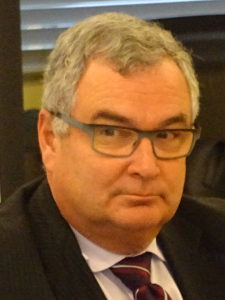 City manager James Ridge is a Toderian fan. As previously reported (Inside Halton Feb 10th 2016) “It was city manager James Ridge who called in his former Vancouver colleague to advise Burlington on intensification and review of its official plan.” Cha-Ching!
OK – so James Ridge in his position as City Manager for COB calls in his ex-colleague Brent Toderian who was fired from his position (without cause) as Director of Planning, City of Vancouver in 2012 after almost 6 years.
 Brent Toderian who was fired from his position as Director of Planning, City of Vancouver. Consults for Burlington. I think it’s only natural to want check this guy out – after all consultants charge LARGE! A quick internet search brought up the following article published in the Vancouver Sun 31 January 2016 by Jeff Lee (the link to the article in below for anyone who would like to read it)
https://vancouversun.com/news/staff-blogs/brent-toderian-fired-as-vancouvers-director-of-planning
This particular article provided a bit of background as seen from a local (Vancouver) point of view. It would appear that the impetus for the firing may have been the fractious relationship that existed between then City Manager Penny Ballam and Brent Toderian – well let’s be honest – there’s no “may have” about it is there ? Consider the following after Hallam herself was ousted from her position as City Manager in 2015.
15 September 2015 – CBC News Vancouver (direct quote)
“When news of Ballem’s departure broke, former Vancouver city planner Brent Toderian, who was let go at the recommendation of Ballem in 2012, issued a tweet simply saying “What goes around, comes around.”
What goes around, comes around. #Vancouver #VanPoli
— @BrentToderian
Speaking to the CBC later, Toderian, who is now a city planning consultant for cities around the world (Cha-ching!), reflected that Ballem’s departure represented an opportunity to change the culture at city hall.
“It really is almost the entire city-making function that is about to be refreshed. That is both challenging and an incredible opportunity. “The morale at city hall has not been the best in recent years, so I think this is a chance to get back to Vancouver city hall being an international model.”
Mmmmm -classy guy – trash your old boss – reveals quite a lot. Type A personality????
So how did we end up in this situation? Like Mayor Goldring I seem to have lost the plot. REVIEW TIME !!!!!
23 March 2015 -James Ridge takes up his position as City Manager (as per COB web site)
11 February 2016 Consultant Brent Toderian arrives at the invitation of ex-collegaue James Ridge to advise Burlington on intensification and review of its official plan -Cha-Ching!
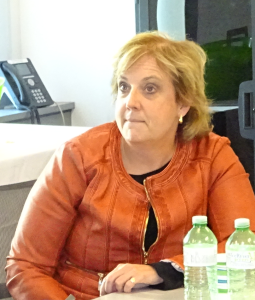 Planning Director Mary Lou Tanner had worked with Brent Toderian before he was invited to Burlington. 21 September 2016 (as reported Inside Halton) Mary Lou Tanner, Burlington’s chief planner and director of building announces that at a cost of $20,000, Consultants BrookMcIllroy -Cha-Ching! have produced the 28 page Tall Buildings Guidelines – she described it as “a living document” that will evolve as staff has more experience implanting it. What does that even mean?
14 November 2016 Consultant Brent Toderian, invited back again to lecture, apparently by the Mayor, but this time with Consultant Jarret Walker (Jarrett Walker and Associates) -Cha-Ching!
8 December The Financial Overview of the 2017 Proposed Operating Budget is presented to The Community and Corporate Services Committee. James Ridge makes a pitch for $550,000.00 in 2017 budget -Cha-Ching!
23 January 2017 (After review and approval by The Community and Corporate Services Committee 16th and 19th January 2017) Council approves the 2017 Operating Budget. Signed, sealed and delivered! Cha-Ching!
25th January 2017 it’s reported that Developer Carriage Gate Homes has dropped the BIG planning application on the planning department’s collective overflowing desk-if approved massive Cha-ching!
Marianne Meed Ward reports it in her news letter as if it was a shock and a big surprise and arranges a public meeting. Sadly though, as correctly reported in this publication, it appears to conform to the Tall Buildings Guidelines – can you say OMB -Cha-Ching!
So after a long journey in response to your very pertinent question posed in the title of your article – “do we need consultants?” As we have seen so many times in the past COB seems totally unable to function without them I suppose the answer must be yes.
 Mayor invited Brent Toderian to speak at one of his Inspire lectures Is Brent Toderian, for example, the right choice for Burlington? I personally find it difficult to imagine a less suitable fit. He appears to have no time for consensus building; according to him you spend your energy convincing the convincible – so does that mean you ignore the yet to be convinced? Absolutely! He never ever wants to hear the words “stable neighbourhood” because in his world they do not exist; his advice is to take those words right out of the conversation.
Unsurprisingly taxpayers are viewed as nothing more than cash cows who then become an annoyance when they dare to try to get in way of “planning” As per the Brent Toderian’s of this world,rip that band-aid off quickly.
Ouch! – lookout residents!
Gwen Lock is a Burlington resident with strong views on how the city uses consultants. She believes choosing Brent Toderian to advise was a mistake.

 By Jay Fallis By Jay Fallis
February 2, 2017
OTTAWA, ON
Amidst the commotion outside the House of Commons doors, I couldn’t help but hear one MP say to another
“What’s going on here?” I think many Canadians are asking that very question as they hear the news that the Liberal Government is going to abandon its plans to reform our electoral system.
In a mandate letter to newly minted Minister of Democratic Institutions and Burlington MP Karina Gould, Prime Minister Trudeau was clear that this once touted election promise was not to be pursued.
“Changing the electoral system will not be in your mandate” it read.
As opposition MPs lined up in droves to criticize the move, I began to realize what all this would likely mean. Electoral reform, the dull policy area turned Cinderella story, was fast losing its footing.
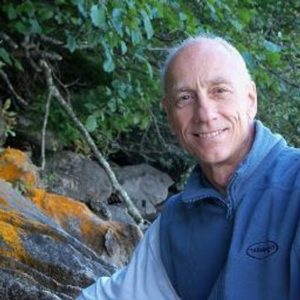 President of FairVote Canada Dr. Real Lavergne. To get a better sense for the situation and the road ahead for electoral reform, I decided to talk to electoral reform advocate and President of FairVote Canada Dr. Real Lavergne.
I opened with the only question I could think of: “Is it over?”
Without hesitation I got the response I had been expecting: “It’s looking over.”
As we talked, it was clear that Dr. Lavergne was disappointed by the Government’s actions.
“I think the NDP bent over backwards and so did Elizabeth May to [bring about] electoral reform… [We all were] looking for a solution that would give us a better system for Canada and this government was simply unable, unwilling, to deliver on its promise. “
Dr. Lavergne’s frustration was no doubt rooted in the all for naught work that had been dedicated to this cause.
For years FairVote Canada and many other actors have been advocating for the country to adopt a proportionally representative electoral system. Trudeau’s election victory had marked the potential turning point, as electoral reform had been outlined by the Liberals as a promise.
Since the electoral reform committee’s first meeting over the summer, politicians, advocates, academics, and ordinary Canadians spent an extensive amount of time and energy to bring about reform. However, despite their best efforts, it seems the government refused to listen.
“[FairVote Canada] wrote a letter to Minister Gould about 10 days ago…. What we were saying was: “look, if you want to reduce the disruption for sitting MPs, there are ways to do that while still bringing in Proportional Representation, here they are… We also said you could have ranked ballot… within the context of a proportional system. If it is within the context of a proportional system and what you are doing is giving voters the opportunity to express themselves in more detail, that’s great! That’s democratic.””
It was clear from what Dr. Lavergne’s was saying that the conditions existed for multiple parties to find consensus. However, despite these efforts, the government was simply not prepared to compromise.
While this announcement certainly marks a setback for electoral reform, Lavergne was confident that the extensive work of the various actors had been worthwhile.
 “I don’t know how many people voted for them strategically in 2015 but I can’t imagine any of those people doing so again… I think it will cost them.” Real Lavergne. “I think awareness for this issue in Canada is at an all-time high….As time goes on, people have been becoming more and more aware of the need for electoral reform. “
He also suggested that the fight to implement electoral reform was far from over.
“Every time there is an election now, people are outraged…. [They] are starting to understand this doesn’t make any sense, this is not democratic. As more and more people understand that, we’re going to have more situations where there is a possibility [for electoral reform] and people will keep fighting for it…This is unstoppable.”
On conclusion, Dr. Lavergne suggested that this could come back to bite the Liberals.
“I think they are going to pay quite a severe price for this. I don’t know how many people voted for them strategically in 2015 but I can’t imagine any of those people doing so again… I think it will cost them.”
As this chapter in our political history comes to a close, electoral reform seems to be lying dead on the operating table. However, maybe the fruition of reforming Canada’s electoral system to be more proportional is an inevitability that just hasn’t been realized yet. Perhaps, as Dr. Lavergne put it:
“The Liberals lost the opportunity to be on the right side of history.”
 Jay Fallis writes on politics for several newspapers in Canada. Jay Fallis writes on politics for several newspapers in Canada.
He covers political events from Ottawa.

 By James Burchill By James Burchill
February 2, 2017
BURLINGTON, ON
The #1 reason your customers walk out the door, never to return is simply this: they feel unappreciated.
Business is personal
A stunning 68% of the people who once walked into your place of business stop doing business with you because they feel you don’t care! That’s almost 3 out of 4 clients who take business personally.
The data proves it:
9% leave because of price issues
14% leave because of quality issues
5% leave because they change their purchasing habits
4% of your customers leave because they simply move away
68% stop doing business with you simply because they feel unappreciated!
 You don’t lose the majority of your customers due to high prices, or poor quality. You lose 68% of your customers simply because you don’t pay enough attention to them! You don’t lose the majority of your customers due to high prices, or poor quality. You lose 68% of your customers simply because you don’t pay enough attention to them!
What Can You Do About It?
The absolute easiest and most ‘hands-off’ way for you to pay attention to them and boost your bottom line each and every month – a simple tactic that only a handful of smart business people use – is this:
Step 1: Contact your customers on a monthly basis.
Step 2: And there’s no better way to stay connected to your customers and clients than a monthly newsletter!
Not exactly rocket science – but it’s true. The simple reason this works so well is because your customers or clients have already spent money with you (they trust you.) And they’ll spend more money with you if you let them, and if you give them a reason to do so. You can’t simply sit back and hope that people will remember your business next time they need your product or service.
 I’m sure you’ve heard the same thing over and over again from every marketing expert. I bet you’ve even considered publishing a newsletter (you may even already do so), but if you’re like most business owners, you just can’t find the time to ever get one published, or get one published regularly … and it’s most likely the writing that ‘gets in the way.’ I’m sure you’ve heard the same thing over and over again from every marketing expert. I bet you’ve even considered publishing a newsletter (you may even already do so), but if you’re like most business owners, you just can’t find the time to ever get one published, or get one published regularly … and it’s most likely the writing that ‘gets in the way.’
No doubt about it, coming up with interesting articles and content is hard work, and unless you have lots of extra time on your hands, it’s easy to keep putting off publishing a newsletter until “tomorrow”.
But of course, we all know “tomorrow” never comes
Yes, that’s the big problem: Who has time to write a monthly newsletter — how do you make a newsletter fun, enjoyable and useful for people to read without making it a full-time job?
A number os smart people who know how important it is to communicate with thier customer outsource the creating of a newsletter to a professional writer.
You get your time back – priceless!
You stop worrying your newsletter won’t be published on time
You can focus on running your business
 You will reduce (or stop) customer loss You will reduce (or stop) customer loss
And by default … MAKE MORE SALES/MONEY
It’s win-win all around.
Of course it helps to know a trusted source that can help you with this project. It’s not something you can just throw together. You need to consider the format, the content balance, the tone, the style, and the images.
 James Burchill has been the associate publisher for two of Canada’s leading aftermarket auto magazines, written over a million words for clients. He has published three business books reached best-seller status online. He currently operates the Social Fusion Network that brings business people together in a friendly social setting. He also produces two trade shows for the local small business market. James Burchill has been the associate publisher for two of Canada’s leading aftermarket auto magazines, written over a million words for clients. He has published three business books reached best-seller status online. He currently operates the Social Fusion Network that brings business people together in a friendly social setting. He also produces two trade shows for the local small business market.

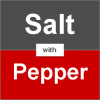 By Pepper Parr By Pepper Parr
February 1st, 2017
BURLINGTON, ON
Bfast – Burlington for Accessible affordable Transit, published a piece on what a consultant said to city council.
They, Bfast, seem to be suggesting that consultants don’t always get it right,
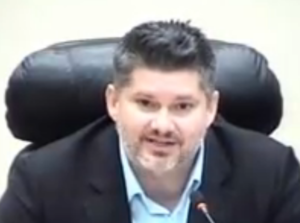 Brent Toderian On February 11th, noted Urbanist and Twitter phenom Brent Toderian was invited to come to Burlington to speak with City Council and Staff, as well as to present to the public as part of Mayor Goldring’s “Inspire Burlington” series.
Here are some things we picked up on from Brent’s presentation to Council:
Brent Toderian’s first point was that we need to change our thinking from being a suburb to being urban. We need to look at three dimensional streets rather than one dimensional roads. He noted that a suburb with more density will result in gridlock and congestion. In order to make this transition, and to position us for success our government needs to treat the Official Plan review as a rethink, not a tweak. Part of this is being willing to fail before we succeed.
Mobility: Brent stressed the need to prioritize transit, walking, and cycling over cars. We now have a very car-centred system meaning that we have to go well beyond the so-called balanced approach to moving budget dollars from cars to transit, walking and cycling. The car as the primary means of getting around has had a 40-50 year head start, so just seeking balance now won’t get us there. He also stressed that in urban places, balance isn’t good enough.
Transit: Brent noted that western Canada’s largest condo developer has said that the key factor in real estate development has changed from “location, location, location” to “transit, transit, transit”. Brent called improving transit “our strongest opportunity” as a city.
 Strategic Plan and Budget: Brent noted that the City’s Strategic Plan was good – but the budget was not. He stated “the truth of a city’s aspirations is not in its plan, but in its budget”. Strategic Plan and Budget: Brent noted that the City’s Strategic Plan was good – but the budget was not. He stated “the truth of a city’s aspirations is not in its plan, but in its budget”.
Making the transition -“pull the bandaid off quick” Brent was very critical of the slow approach re bike lanes. He said this approach maximized the controversy. Instead, he recommended rapid completion of a viable network that would work immediately. He also said that separation was needed on arterials – but not on other streets. Although he cited cycling in this approach, it would also apply to transit.
Prioritize the incentive for taking transit: Brent said that drivers need to see a benefit to take transit for example, bus only lanes that allow buses to move faster than cars.
Parking: Brent emphatically said “get out of Park’n Ride” (will Metrolinx listen?). He suggested that the City constrain the supply of parking.
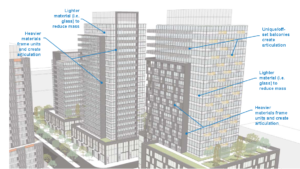 Intensification: Brent discussed how building density right is a challenge because it can result in “the sweet spot of failure”; intensification on too low a scale will create traffic congestion but not enough density to support efficient transit. We need to have an honest conversation about the real cost and consequences to growing the right and wrong ways, with respect to climate change and public health. The starting point of “I don’t want the city to change…” is common, but ‘stable neighbourhoods’ are a lie. All cities are changing in ways beyond the control of local government, so take the word ‘stable’ out of your vocabulary. Cities should reject the idea that there is an optimal number for growth (how big should we get) and worry about quality instead of quantity. Intensification: Brent discussed how building density right is a challenge because it can result in “the sweet spot of failure”; intensification on too low a scale will create traffic congestion but not enough density to support efficient transit. We need to have an honest conversation about the real cost and consequences to growing the right and wrong ways, with respect to climate change and public health. The starting point of “I don’t want the city to change…” is common, but ‘stable neighbourhoods’ are a lie. All cities are changing in ways beyond the control of local government, so take the word ‘stable’ out of your vocabulary. Cities should reject the idea that there is an optimal number for growth (how big should we get) and worry about quality instead of quantity.
Doing the wrong thing better: Painted bike lanes were one example of this; need to make sure we don’t mistake for doing the right thing.
Public Engagement: Your goal should be to convince the convinceable; as leaders you need to change the conversation. Just because we don’t have consensus doesn’t mean we can’t have an intelligent conversation.
Burlington Transit: It was upsetting to hear that Brent Toderian did not get to meet with anyone from Burlington Transit.
As I read through the piece I found myself asking – is this how we decide what kind of a city we want and how we build it? Do we have to bring in consultants who have never lived here, never walked the streets, never attended an event?
Toderian told city council that they need to get rid of rural names – hang on – Walkers Line, Guelph Line and Appleby Line are part of the history and a part of the feel for the city. They remind of us our rural roots.
They no next to nothing about how rich our agricultural background is.
These consultants want to come into town for short periods of time, get very well paid for their time, spout all the most recent flavour of the month in urban design and move on to the next consulting assignment.
 City manager James Ridge – an old friend of Toderian who he had worked with during his time in Vancouver. Toderian got turfed by a th Vancouver city council. Both city manager James Ridge and Director of Planning Mary Lou Tanner, both relatively new to Burlington, knew of Toderian and his work – they thought the guy was great before he had spoken as much as a paragraph. It was almost like he was a member of the club coming back into the circle.
It’s the citizens that decide what kind of a community they want. Consultants have a place and their opinions are important but the people who grew up in the city and want to see it evolve and be something they at least recognize when they are taking their grandchildren to events.
There is nothing wrong with progress and growth – it just has to take place at a pace that works for the people who live here. Why else do we have a community?

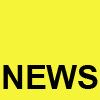 By Staff By Staff
January 30th, 2017
BURLINGTON, ON
At the Committee of the Whole Standing committee meeting this afternoon city council members will be asked to recommend the following Staff Direction:
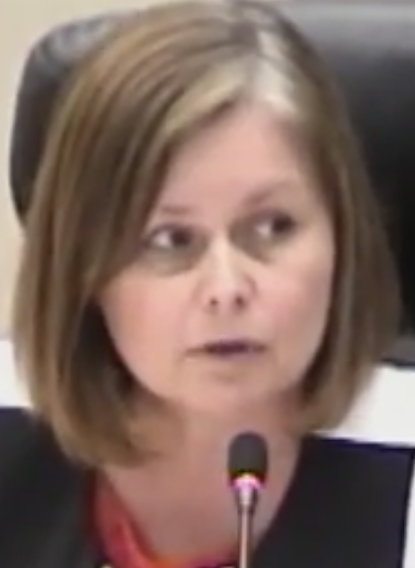 City Clerk Angela Morgan Direct the City Clerk to draft a Code of Conduct for members of Council which addresses, donations, fundraising, sponsorship, entertainment and the acceptance of gifts by members of Council as well as other standards clauses included in Codes across the Province. The Code of Conduct for members of Council should not be less stringent than the Code of Conduct established for City of Burlington staff.
This is close to unbelievable. Most of the members of this council have bobbed and weaved and done everything they can to not have a Code of Conduct.
The Mayor found a way to shuffle this hot potato to the city Manager who has now handed it down to the Clerk.
 Creating a Code of Conduct for members of city council has taken some time – more than five years. There was some resistance amongst the members of council – not all of them. Let’s see what Angela Morgan can achieve.
It might be a useful exercise to pass along any ideas you have on what should be included in the code of conduct to the city clerk. She can be reached by email at: angela.morgan@burlington.ca
If you have words of wisdom for our Clerk and choose to pass them along to her – the Gazette would be interested in what you have to say. You could copy us at newsdesk@bgzt.ca

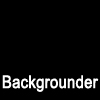
By Jay Fallis
January 27th, 2017
BURLINGTON, ON
For those of you that have been following the electoral reform debate over the last few months, you may be a little disoriented. Initially we saw the appointment of an electoral reform committee that showed great promise. This committee was designed to be representative of the parties in the House of Commons which meant practicing consensual politics could help to bring about a new political mantra in Ottawa.
When the committee hosted its first witness, it was clear that this political cleanse so many had been hoping for would be difficult to achieve. That witness, then Minister of Democratic Institutions Maryam Monsef, while responsive to the committee, did not confirm that the recommendations of the committee would be taken seriously by the Canadian Government.
As the committee continued to meet and witnesses came and went, it seemed that while progress was being made and MPs were interested in the information being presented, there continued to be partisan overtones. This made it difficult to have a neutral educated discussion on the matter as each side tried to convey their own points.
Now, as our Prime Minister wavers on his promise to bring in a new electoral system by 2019, there is concern both on and off of Parliament Hill, that the committee may not have accomplished its objective.
Although there are many good arguments coming from both sides of this debate, the real discussion should come down to one thing: voters should have a greater capacity to influence the results of elections.
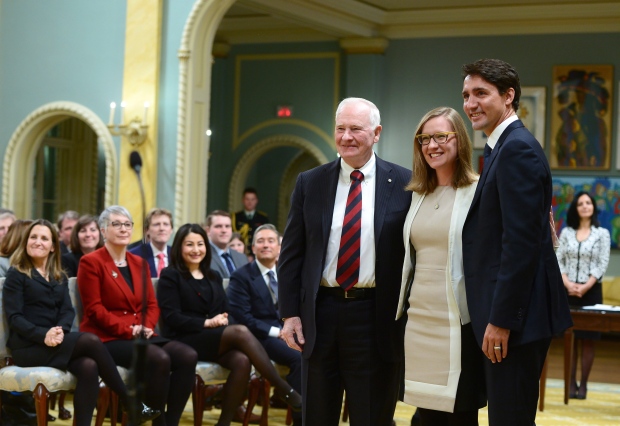 Karina Gould with the Governor General and the Prime Minister after being sworn in as the Minister for Democratic Institutions. In the 2015 federal election, Burlington and Oakville elected three candidates: Liberals John Oliver, Pam Damoff, and newly minted Minister of Democratic Institutions Karina Gould. Together they gained support from 92,611 voters across both cities. However, that meant 102,989 votes, roughly 52.7% of voters from the Burlington and Oakville area, did not influence the final results. How is this fair for those that do not vote Liberal in these two cities?
What would electoral reform mean for residents of Burlington and Oakville? Should anyone here really care?
There have been many different proposals put before the committee, but generally speaking the favoured concept is a family of systems referred to as “Proportional Representation”. This type of system ensures that no matter where a person lives, their ballot will more often than not go toward electing a candidate of their choice.
That might mean that instead of an MP for Burlington, an MP for Oakville North—Burlington, and an MP for Oakville, there would be one MP for Burlington, one MP for Oakville and a third MP representing the entirety of both cities. The advantage of this would be having representatives from at least two parties in the area, ensuring that local interests on multiple sides of the political spectrum are represented. This would also allow residents the opportunity to seek assistance from representatives they feel most comfortable dealing with, and with whom they are politically aligned.
However, the affects to local political practices will not be the only thing that changes under a new electoral system. A proportional electoral system would mean a different form of government. Majority governments, dominated by one political party would become a thing of the past, and coalition governments would likely become the norm.
A coalition government, whereby multiple parties help to form government, are proven to be difficult for the winning party to control. However, there are many advantages that come with these forms of government as well.
 What the current government would have looked like had members of the House of Commons been chosen on a proportional representation model. Experience on the international stage suggests that parties in coalition governments are much more likely to negotiate, meaning that more segments of the Canadian population would be considered during the creation and passing of legislation. Furthermore, the tendencies of coalition governments are to spend more on infrastructure and services while also proving to be more capable of balancing a budget.
While the effects of implementing a proportionally representative electoral system may not be cut and dry, it would seem that many benefits could flow from its implementation for both the country of Canada and the cities of Burlington and Oakville.
However, the government will need to defy both partisan logic and political history to say yes to a system from which many Canadians would likely benefit.
 Jay Fallis writes on politics for several newspapers in Canada. His preference for “proportional representation” is one of several choices available. Jay Fallis writes on politics for several newspapers in Canada. His preference for “proportional representation” is one of several choices available.
Burlington’s MP, Karina Gould, now the Minister of Democratic Institutions, is tasked with bring a recommendation the Cabinet on how, if and when any changes will be made to the way Canadians choose the form of government representation they want.

 By Ray Rivers By Ray Rivers
January 27, 2017
BURLINGTON, ON
Eric Arthur Blair, better known by his adopted non-de-plume, George Orwell, would be in his element were he alive to witness America’s latest president in action. Like Big Brother out of the Orwellian novel ‘1984’, the Trump presidency has been transitioning the English language towards Newspeak. Among the various intricacies of Newspeak was the construct of ‘Blackwhite’ – “impudently claiming that black is white, in contradiction of the plain facts…and to forget that one has ever believed the contrary”.
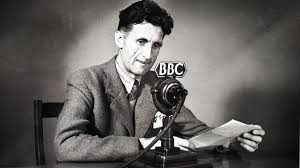 George Orwell – his “1984” was ahead of its time. Is it’s time today? ‘Alternative Fact’ is today’s version of Orwell’s Blackwhite. Trump’s lieutenant Kelly Anne Conway, was being questioned on a US talk show over why the Trump administration was so ridiculously insistent that more people attended the inauguration than actually did. She responded their’s were just ‘alternative facts’. But as any reasonable person knows, ‘alternative facts’ are not facts. They are falsehoods – or worse – out and out lies.
Former dragon, and most recent applicant for the job of leader of the federal Conservative Party, Kevin O’Leary has his own version of alternative facts. He recently complained that Ontario trails Michigan in auto investment because “business there enjoys “30% less in tax, no regulations and no carbon tax.”
First of Ontario doesn’t trail. The two jurisdiction have been alternating closely for first place in auto production in North America, though Ontario actually has a stronger five year record. And according to the Premier, Ontario also outpaced Michigan with a recent $2 billion investment in the auto sector.
 Kevin O’Leary – he will be heard from – will Canadians listen. His candidacy will tell us more about ourselves than about him. To claim that an historic industrial state, like Michigan, lacks regulations comparable to those in Ontario, governing everything from the industrial workplace to the environment is just plain nonsense. It’ is true that Michigan hasn’t, nor is likely to have a carbon tax in the near future. Still the combined federal-state corporate taxes there run at close to 40% (38.9%) compared to the combined rate of only 28.5% in Ontario – Ontario’s tax regime is almost 30% lower.
That O’Leary, the investor, lacks a handle on something as basic as corporate tax rates, or was too lazy to look it up, is inexcusable for someone vying to be our future PM. But then maybe he was just making up stuff, hoping nobody would fact-check – or that no one would care. This is Canada so we should hope he is wrong on that account.
O’Leary has also jumped on the Ontario electricity rate bandwagon. It is true that Ontario’s rates have risen to become among the highest in the country but they are close to those in Detroit and far lower than many other jurisdictions south of the border including New York and Boston, where Mr. Wonderful has a second home and must pays the bills – so should know better.
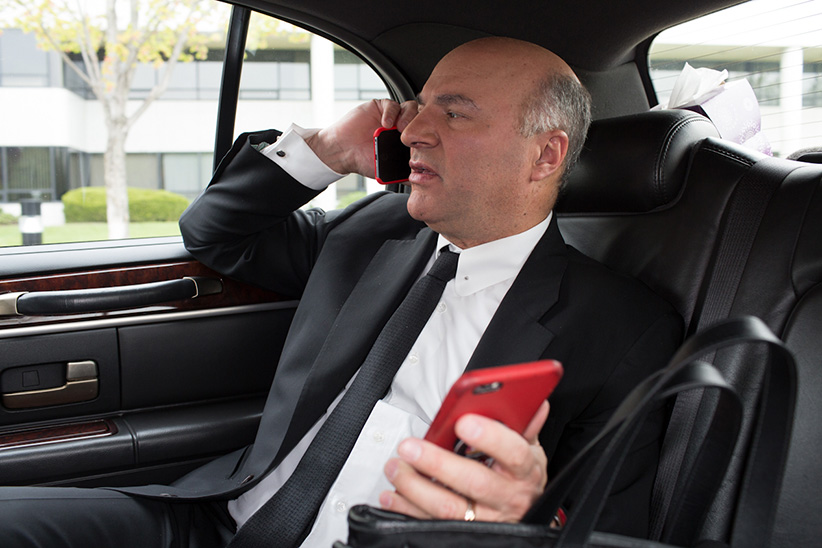 Kevin O’Leary, aka Mr. Wonderful, in New York. (Photograph by Stephanie Noritz) Trump may have spun some big whoppers and got away with it, but O’Leary is not Donald Trump, charisma notwithstanding, So when he finds himself onto the next debate platform, it will be his lack of knowledge of the issues, and his willingness to build his campaign on falsehoods, which will cost him the nomination. For if there is anything Canadian voters expect more of their federal leaders than being able to also speak reasonably fluent French, it is intellectual honesty and competence.
After all, running the country is not a game shown, like the Den or the Tank. But if it were, most Conservative voters should say ‘I’m out’ to O’Leary’s pitch. Perhaps it would be best for Mr. O’Leary to stick to the business he understands and where he has been successful, leaving politics to those who can tell the difference between the facts as they are and the alternative facts as he’d like them to be.
 Seldom at a loss for words and never shy about getting an opinion out – Keven O’Leary will make the campaign trail interesting. O’Leary has been supported by the Toronto Sun and has assembled a team, including former premier Mike Harris. His entry into the race will be an interesting diversion for as long as it lasts. In at least one of his open letters to the Premier he raises some legitimate criticisms. Unfortunately those points will be lost in the dust of the bigger picture – the world of his alternative facts.
In the end, if this is the worst damage our Mr. Wonderful can inflict on Kathleen Wynne, she is doing a far better job than her poll numbers would indicate. And ironically by giving her government new credibility, he may have just thrown the Premier a lifeline and another term in office.
 Ray Rivers writes weekly on both federal and provincial politics, applying his more than 25 years as a federal bureaucrat to his thinking. Rivers was a candidate for provincial office in Burlington in 1995. He was the founder of the Burlington citizen committee on sustainability at a time when climate warming was a hotly debated subject. Tweet @rayzrivers Ray Rivers writes weekly on both federal and provincial politics, applying his more than 25 years as a federal bureaucrat to his thinking. Rivers was a candidate for provincial office in Burlington in 1995. He was the founder of the Burlington citizen committee on sustainability at a time when climate warming was a hotly debated subject. Tweet @rayzrivers
Background links:
Orwell – Newspeak – Alternative Facts –
Wynne-O’Leary – O’Leary – A Gift – O’Leary Not Trump – Ontario Responds –
O’Leary Letter – O’Leary Letter 2 – Electricity Prices –
Autos – Sun Support –

 By James Burchill By James Burchill
January 26th, 2017
BURLINGTON, ON
Social media tools like Facebook and Twitter can be powerful allies in the sales person’s arsenal. The trouble here is context. Many over- or under-emphasize the importance and usefulness of social media in sales today.
 Sometimes those 143 characters are all you need. Not using them is worse than using them badly, some say, while others argue that using them is just a waste of time that should be spent doing other things.
 Facebook can be a tool – but it is never going to replace a face to face sales call. People buy from people. The reality is somewhere in between that. Facebook has shown itself to be a useful tool for keeping contacts alive and pushing information to already-interested or active customers and clients. It is not such a great way to recruit new ones, however, despite all the hype. Twitter is basically the same, though generally more accessible due to its easier use via mobile devices. Every sales person should have both accounts and keep them active.
But how active?
The other problem is time. These tools can really use up a lot of a person’s time and for anyone in business, especially sales, time is money. So the payoff must be balanced with the effort spent for the gain. Facebook is not a replacement for face-to-face meetings and interaction. In nearly all industries, especially more personal ones like insurance, that personal, face-to-face connection is always going to be the top way to sell. Digital revolution or not.
 The scope of the sales relationships are critical – understand the kind of sales network you have and how social media can be made tot work for you is worth spending some time on. Your sales people should be versed in using Facebook and Twitter as tools to enhance the personal, one-on-one connection, not as substitutes for it. Yes, they can decrease the amount of time or number of times you’ll need to see the client in person, but they won’t replace it. The important thing here is to use these tools as if the interaction were actually taking place in person.
Respond personally, with a name if you can, and answer questions or queries quickly and with more than just a link or a “yes” or “no.” The sales person should visualize the person in front of them asking the question, rather than just staring at their iPad or their computer screen and seeing anonymously typed messages. Respond as if you were talking to the person right there. This bleeds through the connection and shows the person you’re interacting on a personal level. Even virtually, online, people respond to that.
 Using social media to connect directly with your prospects – makes sense – just get the message right every time. Social media should be a tool to get or maintain live connections, so treating it as another face-to-face (but not the only F2F) connection will enhance those personal interactions. This leads to better retention, better sales, and more confidence on the part of the client. In insurance, those things are all good things and are what drive repeat sales and continued value.
Finally, sales people should understand what kind of commitment their Facebook and Twitter accounts are going to require and realize that this means something is likely to be sacrificed. Most of the time, though, that sacrifice can be in the travel and personal one-on-one time spent. Many customers will ask questions or submit queries via instant or direct messages (or email) rather than make a phone call. In terms of time, that’s a good thing.
Training and understanding how social media can benefit your sales force is very important and should be a top priority for every business.
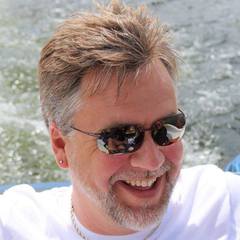 James Burchill is the founder of Social Fusion Network – an organization that helps local business connect and network. He also writes about digital marketing, entrepreneurship and technology and when he’s not consulting, he teaches people to start their own ‘side hustle.’ James Burchill is the founder of Social Fusion Network – an organization that helps local business connect and network. He also writes about digital marketing, entrepreneurship and technology and when he’s not consulting, he teaches people to start their own ‘side hustle.’

 The exchange of opinions between an informed citizen and an elected member of city council can at times be fascinating. This is the kind of conversation that can and should take place at delegations at council The exchange of opinions between an informed citizen and an elected member of city council can at times be fascinating. This is the kind of conversation that can and should take place at delegations at council
The conversation that follows is between Councillor Paul Sharman (ward 5) and Aldershot resident Tom Muir.
The remarks in black are Muir writing. The response from Sharman are in upper case blue letters. Muir’s rebuttal’s are in red.
Muir: I have had some opportunity over the last year or two to hear about the economic plan, strategic plan, and BEDC vision, but have not studied them in any detail.
OK, PLEASED TO DISCUSS THEM WITH YOU AND ANSWER YOUR QUESTIONS.
I’m away for a while so it will have to wait till I return.
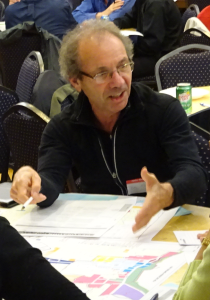 Aldershot resident Tom Muir Muir: You indicate there is an aligned new OP, but I must disagree, as we do not have a new OP as of yet, at least one that has gone through the required public consultation, debate, and Council approval processes under the Planning Act.
YOU ARE CORRECT, HOWEVER, APPROVED REPORTS IN SETTING UP THE OP REQUIRED THAT THE WORK BE DONE IN ALIGNMENT. THERE WAS MASSIVE PUBLIC ENGAGEMENT WITH THE STRATEGIC PLAN. THE OP IS A DETAILED DELIVERY MECHANISM OF THE STRATEGIC PLAN
That’s part of the problem I think. The strategic plan is more about vision, is vague about specifics, and is less concrete and quantitative, which is where the OP enters. Residents are concerned about what the OP will entail with height, density, and intensification. That’s where the concern of disconnection with what residents will buy into, and the push-back is as you know.
Muir: Frankly, I have found it disturbing that the planning department seems to be making up an OP on the run, with developers, into something they would like it to be. The public and affected residents have been disconnected, and have not been given any opportunity for buy-in. Thus you have seen them giving Council push-back, so that way of getting a new aligned OP isn’t working and won’t work until the public processes are completed.
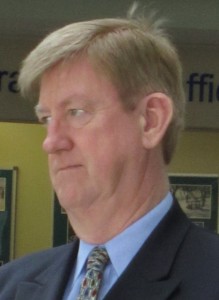 Ward 5 Councillor Paul Sharman THIS IS A GENERALIZED CONCLUSION ON A SINGLE SPECIFIC APPLICATION. ALL OTHER APPLICATIONS HAVE BEEN IN ALIGNMENT. HOWEVER, AS YOU CORRECTLY POINTED OUT ABOVE THE NEW OP IS IN PROCESS OF BEING DEVELOPED AND IT WILL BE REVIEWED AND APPROVED IN PUBLIC AND WITH PUBLIC INPUT. YOUR INPUT WILL BE APPRECIATED
Any generalization I may make is based on several recent years of engaging with INSPIRE talks, several OP related meetings, and development proposals, where it was apparent to residents that the planners were doing just what I described. The recent ADI example is this kind of planning thought in action. The development applications that have been in alignment are, to my experience, those that follow the OP by right height and densities with perhaps some acceptable tweaks.
Muir: Anyways this issue is an aside, and I only said this because you cited it as a part of some grand plan, which is my main point here.
THERE ABSOLUTELY ARE THOROUGHLY THOUGHT OUT, APPROVES, PLANS THAT HAD EXTENSIVE PUBLIC REVIEW. YOU WILL FIND IN THE REPORTS PROVIDED BY STAFF FULL DETAILS OF THE PUBLIC ENGAGEMENT PROCESS.
I think you misunderstand my meaning here. I was only lumping the plans and documents you referred to – strategic, economic, BEDC, – into one grand plan frame. No offense or thoughts that these are not fully proper in the records of process. I did this to fit it into my main points of comment.
Muir: All the plans and so on that you list as being tied into the budget, are high level, visionary, and abstract – they are sort of wish lists, suggesting various paths to follow, and targets to meet. At least this is a summary of what I see these as, for present purposes.
SUCH IS THE NATURE OF PLANNING. STARTS WITH THE BIG STROKES AND DEVELOPS INTO THE DETAILS. BUT THESE ARE NOT SUGGESTIONS. THEY ARE APPROVED BY COUNCIL WITH THE OBJECTIVE OF IMPROVING THE QUALITY OF LIFE FOR THE CITIZENS OF BURLINGTON WITHIN A DEFINED FUTURE TIME FRAME
I’m not disputing what you say. I’ve been involved in many plans myself. The fact they are all approved doesn’t matter in my comment points. Your last point about the quality of life is directly affected by my point raised and further described below. I have been hearing this about improving the lot of citizens for decades, and I see not much that describes how this has actually happened and is manifested. It’s easy to say, hard to deliver, and it needs to be confirmed by the citizens themselves. The budget and financial situation that I am talking about here are very direct measures of this quality of life.
Muir: My comments can be linked to these documents if you consider everything in them as contributing over time to a downstream integrated results endpoint. In my example here, I see this integrated results endpoint as the budget revenue-expenditure level, or gap, whether it be deficit or surplus. In other words, what is the bottom line of the business of the City? You should be concerned about this, but don’t appear to be in an active involved and publicly visible way.
THE BUDGET IS THE SHORT TERM ARTICULATION OF THE STRATEGIC PLAN. THE 20 YEAR TAX RATE SIMULATION IS AN EFFORT TO PROVIDE A BRIDGE. HOWEVER, THE CITY MANAGER IS COMMITTED TO BRING FORWARD A 5 YEAR FINANCIAL AND NO FINANCIAL OPERATING PLAN TO COMPLETE THE INFORMATION YOU SEEK, THIS YEAR. THE BUDGET REVIEW WAS EXTENSIVE BUT PERFORMED BY STAFF AS THEY PREPARED IT. I HAVE REVIEWED ALL THE DOCUMENTS AS WELL AS QUESTUIONS ASKED BY COUNCIL MEMBERS FOR WHICH THE ANSWERS ARE IN THE PUBLIC RECORD IN THE BUDGET REPORTS.
OK, you say there are activities underway to consider this concern. I want to be clear that I am using the conception I describe as a heuristic device to illustrate how all the plans eventually integrate their complexity into the budget, and financial performance, indicated by tax rate changes and revenue-expenditure numbers reflected in deficits and ever increasing taxes or the opposite.
Muir: This gap can be seen as the overall key performance indicator that is the integration of all the upstream planning, vision, and implementation aspects you mention. OK, NOT SURE WHAT YOU MEAN. I mean how the tax rates and increases, or decreases, reflect the gap – deficit or surplus – between revenue and expenditure is a performance indicator of how the upstream planning etc are working out.
Simply putting my point, are we digging the tax hole deeper for residents and business with our plans, or are we gradually building a prosperity fund – an accumulating surplus – and getting a source of leverage for some grander plans for all to enjoy? THE LATTER.I don’t see this in the 10 year forecast that I saw.
My concern, as I described it previously, is that in the 10 year budget forecast the integrated performance indicator of the accumulated revenue-expenditure gap remains in deficit the entire projected time horizon.
NOT SURE WHAT YOU ARE REFERRING TO. PLEASE SEND WHAT YOU ARE LOOKING AT.
As previous point, I saw a 10 year forecast of tax increases in the Gazette, and that’s all I have right now. I imagine Pepper grabbed it from somewhere city official.
Muir: I have to assume that the budget-makers are using forecast of future growth and development, revenue and expenditure, and how these might be affected by the several plans and vision documents you mentioned. So the tax hole is getting deeper the entire budget timeline of 10 years.
YES WHAT YOU DESCRIBE IS THE BASIS OF THE DOCUMENTS. NOT SURE WHAT YOU MEAN BY THE TAX HOLE. HAD INFRASTRUCTURE RESERVES BEEN INITIATED SOONER THAN 2013 THE NEED TO ADD MONEY TO TAXES EVERY YEAR WOULD BE MUCH REDUCED. YOU HAVE EVERY RIGHT TO BE CONCERNED ABOUT THAT NOW, BUT THE BENEFIT TO CITIZENS WAS THAT THEY ENJOYED LOWER TAXES OVER THE LAST MANY YEARS.
The tax hole is the ever-increasing tax take that just keeps increasing exponentially, produced by continuing deficits. I’m afraid the last sentence in this point should have been at the end of the previous paragraph. This is what I see for the 10 year forecast, and is the basis of the concern about doubling due to exponential increases.
Muir: So, in keeping to my point, the budget does not reflect a favorable performance of these high level, visionary, grand plans, as they appear when integrated, to continue to dig the tax hole deeper and the deficit gap continues.
BY THE WAY, ALTHOUGH CITY BUDGET INCREASED BY OVER 4% THE ACTUAL TAX INCREASE IS LESS THAN 2% FOR THE CITY COMPONENT AND THE TOTAL TAX INCREASE WILL BE ABOUT 2.66% COMPARED TO TORONTO INFLATION OF 2.19%. OF COURSE IT IS DILUTED BY A ZERO EDUCATION BUDGET INCREASE AND A REGION BUDGET INCREASE OF 1.9%. BUT WOULDN’T YOU RATHER FIX THE INFRASTRUCTURE HOLE UNDER THOSE CIRCUMSTANCES THAN WHEN EDUCATION AND THE REGION ARE STRUGGLING WITH SIMILAR INFLATIONARY CHALLENGES WITHOUT THE BENEFIT OF ASSESSMENT GROWTH.
This may all be true, but it is irrelevant to the concerns raised last year, and this year again, about the 10 year forecast of exponentially increasing city tax take. We are talking City and it doesn’t help with credibility to hide some concern behind the education and region increases that average the tax rate increase down.Your comment about education and region rates is double-edged, as I think they form a risk moving ahead and part of my concern. What happens if this changes negatively and what is the city going to do. And by the way, don’t forget the region charges for water and sewer separately from the taxes, and that always seems to increase substantially. So taking this into account is needed for a fair representation of the region’s tax or tax-like take.
Muir: This never-ending deficit will not help with development and growth in the city, but will in fact as as a damper on the ability of small and large business to thrive and survive.
MUCH HAS BEEN DONE TO REDUCE COSTS IN THE LAST 6 YEARS INCLUDING LOW TAX RATE INCREASES, A CAP ON HEADCOUNT SET AT 2010 LEVELS AND COMPENSATION LEVEL EQUAL TO INFLATION OR LESS IN COMPARISON TO 5% YEAR FOR A NUMBER OF YEARS LEADING UP TO AND THROUGH 2010. ALL OF THAT WAS OFFSET BY HAVING TO RAISE FUNDS FOR THE HOSPITAL….. ACTUALLY, THE CITY HAS DONE REMARKABLY WELL.
But that is not the point I made. For the next 10 years the city is in deficit, with increasing taxes, from what I saw, however remarkably well they have done as you say. I should have said something about homeowners and residential taxes, also not helping with citizen quality of life. It also feeds right into the inflationary cost of housing that we are experiencing.
Muir: This summarizes, and provides a basis for, my concerns.
AS I SAID, IT IS A COMPLEX ANALYSIS THAT SOME SIMPLIFY INTO ASSESSING THE ANNUAL BUDGET INCREASE.
Your statement seems to take my point too lightly. The complexity all channels downstream to a financial and budget performance integrated endpoint. This is not just simplified, as there are complicated flows that are integrated from your picture of complex analysis. The end result of all the complexity is the gap – deficit or surplus – and is it increasing or decreasing, positive or negative. I do not see anything but deficit for the entire 10 years of the city plans and strategy, according to the financial and budget info on the table right now. The annual budget increase is being driven by the complexity and the plans and strategies that are not delivering performance measured financially as not in deficit.

 By Tom Muir By Tom Muir
January 21st, 2017
BURLINGTON, ON
Part 6 of a series
Tom Muir, an Aldershot resident, has been an active participant in civic affairs or more than 25 years. He has been described as “acerbic”, a fair term for Tom.
He has outlined, in considerable length, a large part of why the parents at Central and Pearson high schools are in the mess they are in as a result of the recommendation to close their schools. In this article, one of a series Muir suggest what he feels are obvious solutions to the problem the Board of Education believes it has. There is a lot of material; it gets dense at times. Living in a democracy means you have to accept the responsibility of citizenship and stay informed.
What does the city do?
This school closing issue and decision-making process is by definition political.
That makes it personal, so we are all involved, elected official or not.
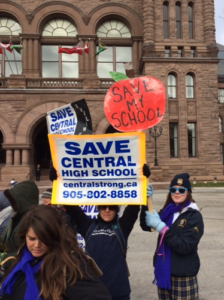 Is saving a school the same as saving a community? The City is involved regardless of opinions. Elected city officials and city staff are involved as our representatives. I want them to comment on what various options and issues mean for the city.
This is their job, and if they don’t want to do this for their own “political” motives then they have lost their way, and are not representing us.
And I have to wonder what the Mayor is thinking when he avoids involvement, saying it’s political, which is just a truism, and thus a disingenuous dodge, in my opinion. He’s playing politics himself.
City Manager Jim Ridge has been appointed to the PARC to represent the City, and I can only hope that he takes a full briefing to that table of the many City interests that are involved and at stake in this issue.
It’s not just Central and Pearson on the block – everything and every school, including elementary, are in there somehow, and in some way.
It is not just a school board issue, although they have the vote, and make the final decision.
I realize that the decision is for education trustees to make, but Councilors that claim they have no role whatsoever are abdicating their duty to politically represent residents and the city as a whole.
To say that the city has no interest in whether there are schools in the city or not is just out to lunch. The city has key interests, which are obvious.
 City manager James Ridge will represent the city on the Program Accommodation Review Committee. What is his mandate and is it public? These interests need to be outlined by the City and Council, and injected into the debate and dialogue.
Jim Ridge can take these to the table, but the Council and Mayor must take their public responsibilities in this matter seriously and not dodge the political reality they are elected and empowered to carry forward.
If the intensification development plan that the Mayor and city are pushing does not need a school in the downtown, where 70% of the new is supposed to go, then the plan is fundamentally flawed in its conception and contradiction with any closure plan.
There’s no “complete communities” in this plan, and never will be if it happens.
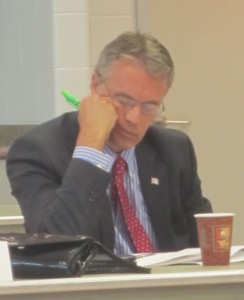 Mayor Goldring decided he would have the city manager represent the citizens on the Program Accommodation Review Committee. It was a controversial decision. Let’s hear from the Mayor and Council on this. We need a motion to direct staff to provide a report on potential school closings and the strategies that can be developed to protect community assets for future generations.
I would start with the following investigation. I would like Jim Ridge to direct staff to examine what the City and communities will lose if schools close, considering at least the following.
We all know that schools have many uses and many values. They are not just for educating the young during the day. It shouldn’t matter that they are not completely full right now – the neighborhood needs them for the future, which will certainly change, and this change is evident now.
People come and go from our schools at many times of the day and week all year, and for many reasons. I ask that the City document all these comings and goings, all of the ways that people interact with the schools.
They belong to the residents that fully paid for them, and own them, and the school board holds them in trust, or is supposed to.
They are a bought and paid for part of the community fabric, the community capital stock, and an asset that has many uses and values, including recreation, sports, social clubs, adult education, clubs, green-space, heritage, school spirit, memories, diversity of city form and landscape, and the list can go on.
They contribute to property values and a sense of the familiar and well-being – the quality of life.
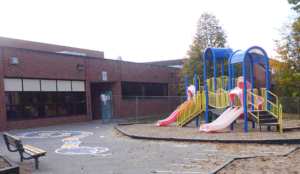 Pearson was a purpose built school -intended to serve both students and a wider community. Are the Catholics going to be able to come to terms with the Board of education and acquire the property? Are not most schools considered to be community schools? These interactions are in fact part of the glue that ties neighborhoods and communities together.
This will include recreation, sports and athletics, adult education, day care, social and other clubs, public meetings, and any other activity that uses the school buildings and property.
Indeed, the Alton (Hayden) school construction and opening was delayed 2 years because of the partnership between the Board and the City of Burlington to augment the on-site facilities, with city funding, providing 8 gymnasiums, a library, and community meeting spaces.
So this city partnership shows there is a clear city interest in this matter and issues arising.
I also ask that you consider how the schools enter into the City parks and green-space plans, and into good municipal planning in general.
What about the loss of property values, since we all know that schools, and green-space in a neighborhood, add to the price of housing there.
Is the City prepared for assessment appeals and the loss of tax revenue, or is this something to be ignored, and denied when the time comes?
We need a certain irreducible level of schools capacity, and this includes an appropriately located capacity to have schools.
So my point is we need schools everywhere they were built. The extra capacity is money in the bank to buffer the changes that are certainly going to come from the growth and changes the city is facing, and that the province and Council are advocating.
I don’t think it can be said that we absolutely have too many schools, and especially too much and too many of the functions and products and factors that schools represent and deliver to people.
So the city has a big stake in this for all the things I listed, and Council has a responsibility to the residents they represent to pay attention to these things and account for them.
This is no time for silos, artificial divisions, and neglect of care and concern for these things.
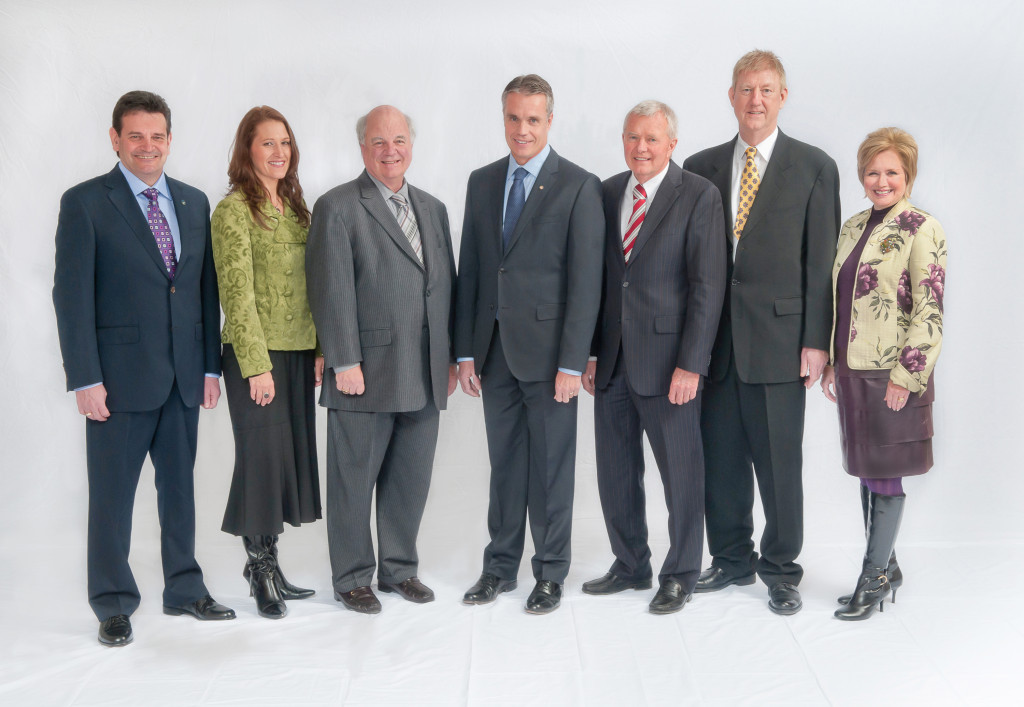 Is a Board of Education matter likely to become an election issue for city council? So let’s stop talking about closing schools right off the bat, as a starting opinion, and exhaust ourselves figuring out creative and adaptive ways to reconfigure how we make do and keep what we have.
We will surely need it sometime in the future.
Following this we need a City organized public debate on this threatened confiscation of community assets and the multi-faceted impacts on the city.
If Council can’t see their role in this important matter, that goes to the heart of everything the city is planning – strategic plan, growth, Official Plan, intensification, community, and so on – then, again I say, they have lost their way.
 Tom Muir is a resident of Aldershot who has been a persistent critic of decisions made by city council. He turns his attention to the current school board mess. He recently suggested to Burlington city council that “If you are so tired of and frustrated by, listening to the views of the people that elected you, then maybe you have been doing this job too long and should quit. Tom Muir is a resident of Aldershot who has been a persistent critic of decisions made by city council. He turns his attention to the current school board mess. He recently suggested to Burlington city council that “If you are so tired of and frustrated by, listening to the views of the people that elected you, then maybe you have been doing this job too long and should quit.
Muir explains that the PARC will only get what people send in, what they come up with from their own efforts, and what they ask/demand from the board. They have to decide what they want and go after it ruthlessly. They will have to fight with tooth and claw and take no prisoners.
Previous articles in the series.
Part 1
Part 2
Part 3
Part 4
Part 5

 By Tom Muir By Tom Muir
January 20th, 2017
BURLINGTON, ON
Part 5 of a series
Tom Muir, an Aldershot resident, has been an active participant in civic affairs or more than 25 years. He has been described as “acerbic”, a fair term for Tom.
He has outlined, in considerable length, a large part of why the parents at Central and Pearson high schools are in the mess they are in as a result of the recommendation to close their schools. In this article, one of a series Muir suggest what he feels are obvious solutions to the problem the Board of Education believes it has. There is a lot of material; it gets dense at times. Living in a democracy means you have to accept the responsibility of citizenship and stay informed.
The Gazette published the results of the 25 questions put to residents at the public meeting held by the Board on December 8.
There has been some concern expressed that the responses may be biased because of the representation by school is not even.
This is because all of the schools are not explicitly named as the primary option for closures, so there is a selection bias built right into the sampling frame itself, used by the Board consultant.
This sample of the resident/parent/student populations reflects the selection of schools that are directly named for closure or other changes – Central, Pearson, and Hayden. It is expected that the population of these schools would self-select to participate.
The low turnout from the other schools is also expected on similar grounds as not being in the selected schools directly affected.
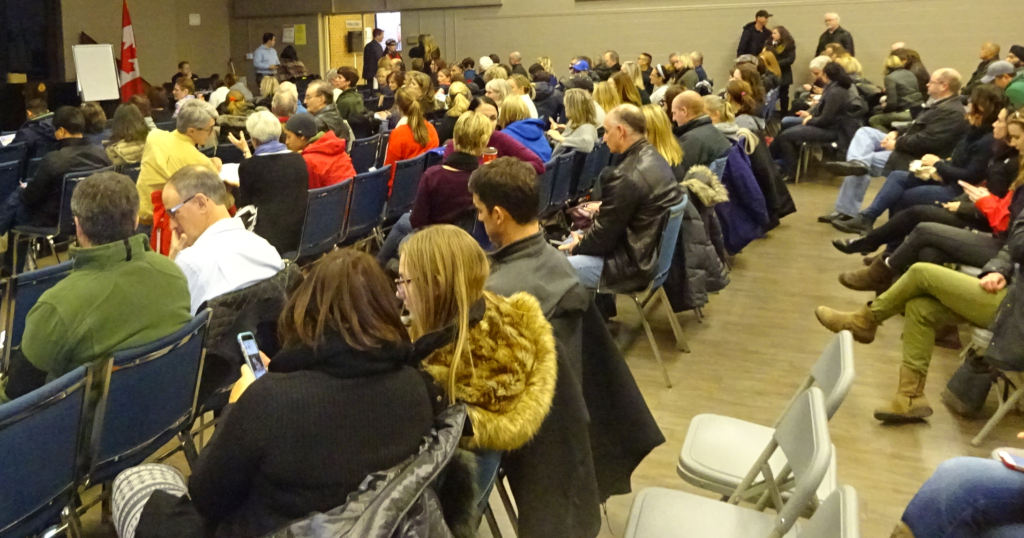 These are the parents that answered the 25 questions put to them by the Ipsos facilitator the Board of education hired to collect and analyze the data. The vast majority of them were from Central high school. In my opinion, the selection of schools is biased, so the turnout population sample reflects this bias – in effect the net bias balances out.
This is my summary of the details of the responses. The opposite views and votes are found by subtraction from 100%.
When you consider these closely, you can see what parents think about what they were asked, and what they want.
We have set out all 25 questions and the responses to each question – they are shown in red.
The Questions and the responses:
Question 1: Which high school are your representing tonight? The number beside the school was the number people in the audience would key in. The screen displayed a number that indicated how many devices had been handed out and another number showing how many people had responded.
7. Aldershot 7
6. Dr. Frank J. Hayden 43
5. Lester B. Pearson 43
4. Nelson Public 6
3. Robert Bateman 5
2. Burlington Central 150
1. M.M. Robinson 2
Question 2: How important is the availability of mandatory / core courses for your child(ren) within your home school?
3. Very Important 187
3. Somewhat Important 58
2. Not Very Important 12
1. Not at all Important 3
Question 3: How acceptable is it to attend a school outside of a home school for mandatory / core programming for your child(ren)?
4. Very Acceptable 22
3. Somewhat Acceptable 42
2. Not Very Acceptable 64
1. Not at all Acceptable 135
Question 4: How important is the availability of optional / elective courses within your home school for your child(ren)?
4. Very Important 94
3. Somewhat Important 117
2. Not Very Important 38
1. Not at all Important 14
Question 5: How acceptable is it for your child(ren) to attend a school outside of a home school for optional/elective courses?
4. Very Acceptable 37
3. Somewhat Acceptable 92
2. Not Very Acceptable 70
1. Not at all Acceptable 62
Question 6: How willing are you to have your child(ren) take a mandatory/core course in an alternative method (e.g., summer school, night school, e-learning or attend another school?
4. Very Willing 55
3. Somewhat Willing 54
2. Not Very Willing 57
1. Not at all Willing 96
Question 7: How willing are you to have your child(ren) take a optional/elective course in an alternative method (e.g., summer school, night school, e-learning or attend another school?
4. Very Willing 90
3. Somewhat Willing 74
2. Not Very Willing 46
1. Not at all Willing 49
Question 8: How important is it for you high school to offer a full range of pathway programming (e.g., workplace, college, university)?
4. Very Important 120
3. Somewhat Important 89
2. Not Very Important 33
1. Not at all Important 15
Question 9: How concerned are you that your child(ren) has access to appropriate learning facilities (e.g., kitchens, science labs, gyms, libraries)?
4. Very Concerned 165
3. Somewhat Concerned 58
2. Not Very Concerned 16
1. Not at all Concerned 19
Question 10: How concerned are you that some high schools have large amounts of specialized learning spaces that remain underutilized?
4. Very Concerned 18
3. Somewhat Concerned 56
2. Not Very Concerned 92
1. Not at all Concerned 92
Question 11: How important is it for your home school to have a full range of extracurricular activities (e.g., drama, arts, athletics, clubs) for your child(ren)?
4. Very Important 121
3. Somewhat Important 92
2. Not Very Important 35
1. Not at all Important 13
Question 12: How likely are you to support your child(ren) participating in extracurricular activities at another school?
4. Very Likely 72
3. Somewhat Likely 69
2. Not Very Likely 49
1. Not at all Likely 68
Question 13: How important is it for your child to have access to the highest level of competition in athletics?
4. Very Important 19
3. Somewhat Important 30
2. Not Very Important 170
1. Not at all Important 141
Question 14: How important is the physical condition of your existing school to you (e.g., environmental sustainability, energy consumption, safety)?
4. Very Important 75
3. Somewhat Important 37
2. Not Very Important 32
1. Not at all Important 95
Question 15: How important is it to you that the board ensures schools have an up-to-date, fully-accessible learning environment (e.g., elevators, air conditioning)?
4. Very Important 56
3. Somewhat Important 38
2. Not Very Important 32
1. Not at all Important 116
Question 16: How important is it you to preserve existing community partnerships at your child(ren)’s current school (e.g., swimming pool, library, community centre)?
4. Very Important 97
3. Somewhat Important 36
2. Not Very Important 49
1. Not at all Important 69
Question 17: How important is it you to minimize the use of portable classrooms?
4. Very Important 159
3. Somewhat Important 27
2. Not Very Important 27
1. Not at all Important 39
Question 18: The Board’s current walk distance is a maximum of 3.2 km. How important is it that your child(ren) are within the Board mandated walking distance to reach school?
4. Very Important 198
3. Somewhat Important 22
2. Not Very Important 21
1. Not at all Important 12
Question 19: Which of the following is your child(ren)’s most common form of travel to school currently? (list methods)
6. School Bus 37
5. Car (drive or drop off) 32
4. Public Transit 0
3. Walk 176
2. Bike 17
1. Other 4
Question 20: How important is it to you that the Board be fiscally responsible by reducing transportation to reach school?
4. Very Important 151
3. Somewhat Important 44
2. Not Very Important 22
1. Not at all Important 30
Question 21: How important is it for your child(ren) to spend their secondary school years in one school community?
4. Very Important 238
3. Somewhat Important 14
2. Not Very Important 6
1. Not at all Important 0
Question 22: The Ministry does not fund empty pupil places. To what extent do you agree that the Board should reallocate its limited budget to fund these spaces?
4. Strongly Agree 122
3. Somewhat Agree 50
2. Somewhat Disagree 32
1. Strongly Disagree 28
Question 23: The Board’s MYP states it will maintain a minimum overall average of 90% building capacity. To what extent to do you agree with this goal around future sustainability of Burlington secondary schools?
4. Strongly Agree 20
3. Somewhat Agree 34
2. Somewhat Disagree 53
1. Strongly Disagree 134
Question 24: The goal in the current MYP is to use innovative approaches to student learning spaces (e.g., classrooms, gymnasiums). To what extent do you feel the current situation of Burlington high schools is sustainable?
4. Very Sustainable 91
3. Somewhat Sustainable 55
2. Not very Sustainable 20
1. Not at all Sustainable 25
At this point people began walking out. Answers for the 25th question were not collected.
Question 25: Of the four themes, which is most important to you?
4. Programming and enrollment 0
3. Physical state of existing schools 0
2. Geographical and transportation Issues 0
1. Fiscal responsibility and future planning 0
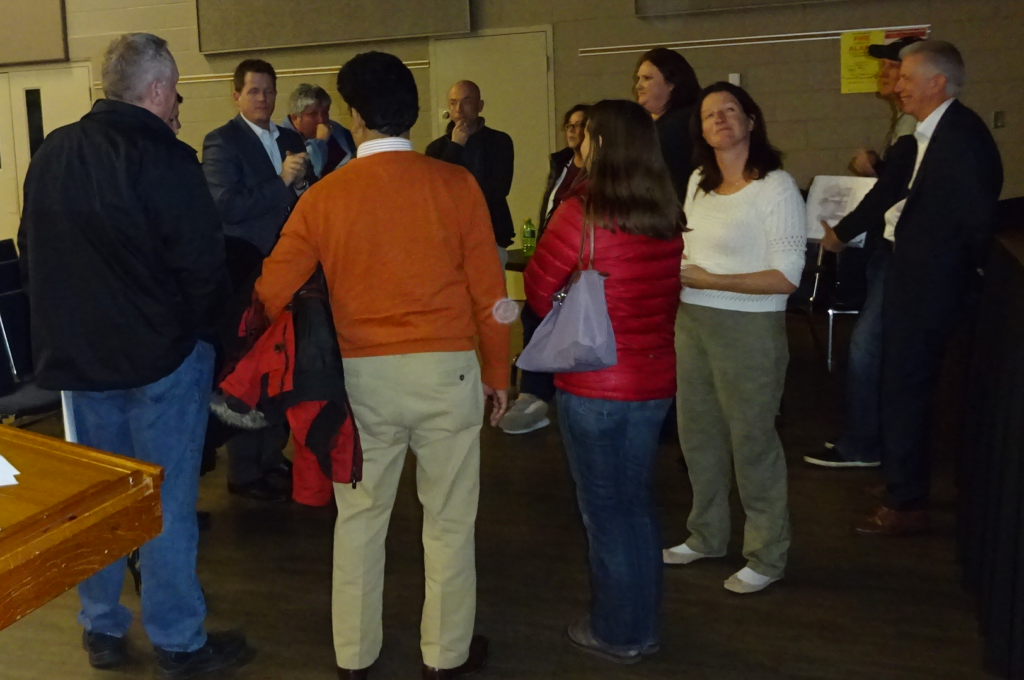 Very little is known about the parents who are members of the Program Accommodation Review Committee other than that they have a tremendous amount of work ahead of them. There is no remuneration for the members of the committee. Tom Muir’s analysis of the answers that were given to the questions asked.
Readers are going to have to shift up and down the pages to read the question and all the responses Muir has analyzed. Awkward – but it was the only way to set the data out for readers.
1) It is apparently important there be no school closures:
– the Board allocate the budget to fund empty spaces (Q22, 74%);
– present empty spaces are sustainable (Q24, 76%) – question also said MYP goal is to use innovative approaches to learning space use;
– response disagrees with Board 90% utilization goal (Q23, 78%);
– response not concerned about empty spaces being underutilized (Q10, 71%).
2. The importance of the home schools for core/mandatory subjects, and even optional/elective, is quite emphatic (Q2, 94%; Q3, 76%; Q4 80%; Q6, 58%; Q5, 51%), and consistent;
– Q7 indicates some support (63%, but only 35% are very willing), for optional/elective in alternatives like summer school, night school, e-learning, another school.
– do not agree with the Board 90% utilization goal (Q23,78%);
– and again, want the Board to allocate the budget to fund empty spaces (Q22, 74%);
– see being within 3.2 km, or 2 mile, Board mandated walking distance to home schools as important (Q18, 86%) – 69% already walk, 14.5% ride bus (Q19);
– see reduction in bus transportation to each school as important (Q20, 79%);
– see spending secondary years in one school as important (Q21, 98%);
– are concerned that appropriate learning facilities be accessible (Q9, 86%);
– want a full range of pathway programs (Q8, 81.3%);
– feel current situation is sustainable – as above in 1. (Q24, 76%);
– see it as important to minimize the use of portables (Q17, 74%).
4. Suggesting further support for retaining all schools are the following:
– a full range of extra-curricular activities (e.g., drama, arts, athletics, clubs) is important (Q11, 82%) – in my view, this implies more schools with more space for fewer students, means more opportunities;
– parental support to help students do extracurricular at another school is not at all likely, or not very likely, for 45% of respondents, compared to 55% at somewhat or very likely (Q12);
– the importance of the highest level of competition in athletics is not important (Q13, 81%) – in my view, this implies the larger top tier schools with large student populations are not important in this regard.
5. Other parent/resident views reflect a small majority percent expressing that:
– the physical condition of the school as not at all or very important (Q14, 53%);
– that the importance of the school as up-to-date and fully accessible, with elevators and air conditioning, is not at all or not very important (Q15, 61%);
– preserving existing community partnerships at current school (pools, libraries, community center) is very to somewhat important (Q16, 53%).
Again, the opposite views and percent support can be derived by subtraction with regard to response preference bracket.
I believe my analysis is accurate. It is unbiased and done in good faith.
 Tom Muir is a resident of Aldershot who has been a persistent critic of decisions made by city council. He turns his attention to the current school board mess. He recently suggested to Burlington city council that “If you are so tired of and frustrated by, listening to the views of the people that elected you, then maybe you have been doing this job too long and should quit. Tom Muir is a resident of Aldershot who has been a persistent critic of decisions made by city council. He turns his attention to the current school board mess. He recently suggested to Burlington city council that “If you are so tired of and frustrated by, listening to the views of the people that elected you, then maybe you have been doing this job too long and should quit.
Muir explains that the PARC will only get what people send in, what they come up with from their own efforts, and what they ask/demand from the board. They have to decide what they want and go after it ruthlessly. They will have to fight with tooth and claw and take no prisoners.
Previous articles in this multi part series
Part 1
Part 2
Part 3
Part 4

 By James Burchill By James Burchill
January 20th, 2017
BURLINGTON, ON
Today I’ve decided to share with you a new word that recently made a special appearance in my daily life: eponym. It is pronounced (EP-uh-nim) and I have to be frank, but I was somewhat at a loss when I saw it.
 James Burchill at one of his Social Fusion events congratulating a guest who won a bouquet donated by Brant Florist, I mean, I write, communicate and persuade using words for a living…but this one had obviously been hiding somewhere far away because although I could pronounce it, I could not recall its meaning.
So I grabbed my dictionary… then I realized that I now reside in the 21st Century… so I put down the book and I went on to the ‘Net’ instead. I found the definition (actually I found a few versions) and then settled on the one I’ve included below.
In A Word
One way that we use the word “eponym” (EP-uh-nim) is in reference to a specific brand name that has come to mean a generic product. Examples:
 Jacuzzi has become an eponym for a type of product – when it is really a well developed and valuable brand name. Jacuzzi = whirlpool bath
Band-Aid = plastic bandage
Chapstick = lip balm
Jell-O = gelatine dessert
Kleenex = facial tissue
Q-Tips = cotton swabs
 Bit of cotton on a plastic stick – with the brand name Q tips which made all the difference. Scotch Tape = cellophane tape
Styrofoam = plastic foam
Teflon = non-stick coating
Vaseline = petroleum jelly
Walkman = portable cassette player
Xerox = photocopier/photocopy
Sounds fantastic doesn’t it. I mean, your own name or your product name being so popular that it has been absorbed in to the general vocabulary. Now that’s branding at work… that’s branding on ‘go-go’ juice!
But hold on a moment! You might think this is really great ‘branding’ however I’d like to offer an alternate viewpoint…
Too Much Of A Good Thing
If you were the lucky/unlucky manufacturer of ‘band-aids’ you’d now be in the unfortunate position of seeing your brand lose most of its value because it has passed into the vocabulary of the buying public as a GENERAL term.
Your product which you worked so hard to promote… has lost all its specificity. In other words, your product branding is now helping the competition sell there alternate ‘band-aid like’ products.
Brand Life Cycles
You’ve probably heard me say that for most of us (probably 80% or more) we need to focus on selling not brand building. Sure branding is a great add-on if you can do it, but you have got to have deep pockets to pull it off successfully. And you’ve have to be very, very, very patient.
Assuming that you create the next super brand, and your product takes on a life of its own, there will be that first glory phase when your products name will be uniquely linked to you, your product and the benefits and value it provides.
If you keep going strong your product will be synonymous with the brand name… and eventually the unthinkable will happen: One day, the buying public will use your product name – your brand name – to refer not to your specific product, but to the family or type of product!
The End Of An Ear… Or Is That Era?
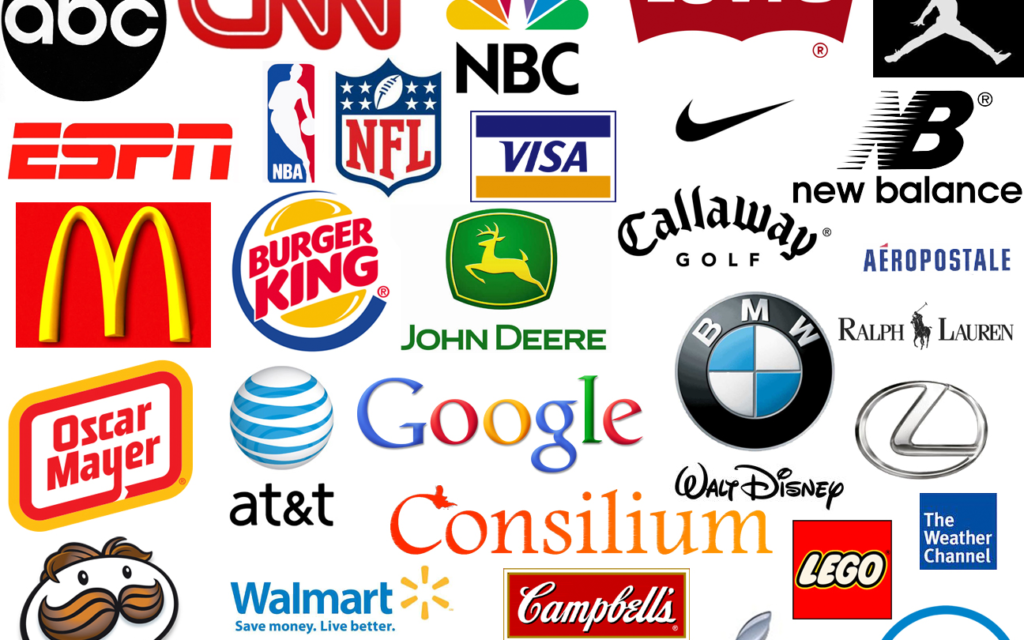 You don’t have to turn your company into a brand name – but if you can create a brand name – you’ve added value to the company. From that day forth, your product name, your brand name will now be an eponym. You’ll be the Kleenex of facial tissues, the band-aid of plasters, the Teflon of non-stick coatings. Life will be grim…
Of course, you’ll be filthy stinking rich at that point and whether you get another dime off the brand name is really neither here nor there.
But I’m sure you see my point. The brand is born, it develops over time, if you’re lucky it is welcomed by the masses and they embrace your brand product. It over stays its welcome and eventually becomes a mainstay of conversation – the end.
Do you think Good Year or Pirelli or Firestone or some of the other tire manufactures will suffer that ignominious fate?
They should be so lucky – until next time.
 James Burchill is the founder of Social Fusion Network – an organization that helps local business connect and network. He also writes about digital marketing, entrepreneurship and technology and when he’s not consulting, he teaches people to start their own ‘side hustle.’ James Burchill is the founder of Social Fusion Network – an organization that helps local business connect and network. He also writes about digital marketing, entrepreneurship and technology and when he’s not consulting, he teaches people to start their own ‘side hustle.’

 By Tom Muir By Tom Muir
January 19th, 2017
BURLINGTON, ON
Part 4 of a series:
Tom Muir, an Aldershot resident, has been an active participant in civic affairs or more than 25 years. He has been described as “acerbic”, a fair term for Tom.
He has outlined, in considerable length, a large part of why the parents at Central and Pearson high schools are in the mess they are in as a result of the recommendation to close their schools. In this article, one of a series Muir suggest what he feels are obvious solutions to the problem the Board of Education believes it has. There is a lot of material; it gets dense at times. Living in a democracy means you have to accept the responsibility of citizenship and stay informed.
I have set out what I think is the background reason for the situation Burlington parents and their high school level students face with the possible closing of two high schools in the city and I have suggeted that the mess we asre in is one we created for ourselves.
How do we get out of the mess?
Where does the Board staff appear to sit?
The Board seems to be into closing schools. Almost all the options close schools. Some seem nonsensical. I was surprised by this very limited plan.
They say 1800 empty seats is not sustainable long term. And the Board staff data is said to be accurate now, and and has been accurate in the past.
Go back to the Board data for 2010 when there were 495 actual empty seats, and 92% space utilization, in the 6 then existing schools in Burlington.
They developed plans, with no evident justification, to build another school in Alton – add 1200 seats plus about 280 in portables.
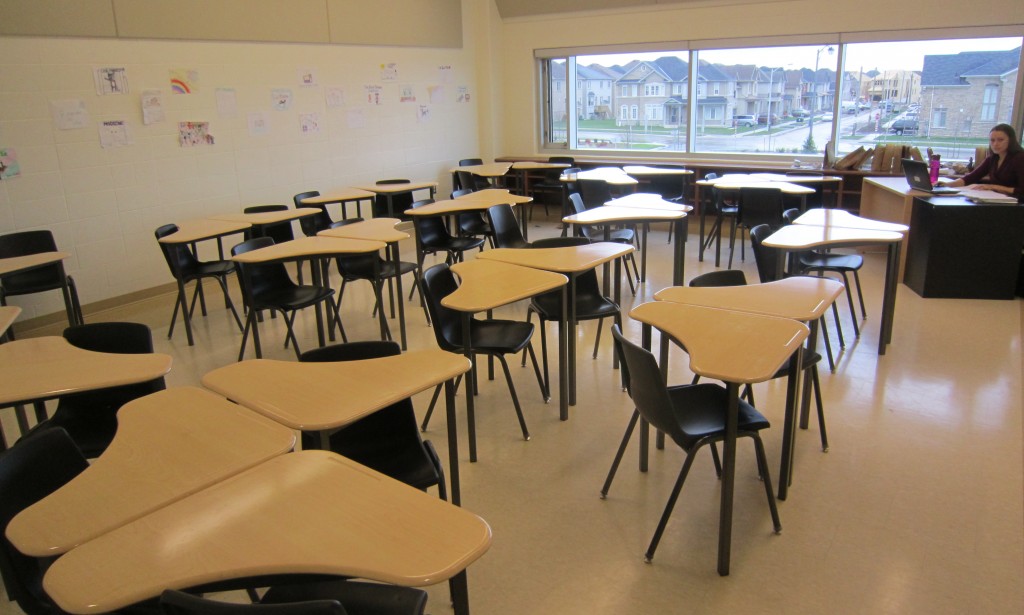 Empty classroom seats. Burlington has 1800 of them. These seat are in Hayden high school which some feel should not have been built. The recreation centre and the library made sense – the facts suggest the building of a high school in Alton created the problem that exists now south of the QEW. Build school, open in 2013, fill with about 1400 students by 2017, mostly from schools within the six existing high schools. These 1400 now become empty seats in the south Burlington six high schools.
This adds up to about the 1800-1900 now cited as unsustainable.
This is based on the past and forecast data that is said to be accurate.
So it can be said with accuracy that the Board created the 1800 empty seats that they now say are not sustainable. Why and how?
Building Hayden in Alton can be said with accuracy to be a blundered construction of most of the 1800 empty seats.
So they now want to close two schools of the original six that housed all these students, before Hayden, within the comfortable 90% utilization.
So the Board itself created this so-called unsustainable 1800 empty seats, and they did it with accuracy.
They have also gotten away with this unexplained blunder with no accountability for what is incompetent planning in my opinion, based on the face of the so-called accurate data.
 Director of Education Stuart Miller during an on-line Q&A which some parents thought was rigged. So how does this work that the Director isn’t sure now what the residents/public of the south Burlington six expect from him and the Board?
Well, what I expect is that the Director offer innovative and management solutions to clean up the mess you have created.
And don’t tell us that your forecast data are accurate. It’s seems to be a new age for housing costs and form, so families will likely have to more and more occupy higher density.
The historical pupil yield curves used may be too low in this new age. That’s what happened in the Alton community, and the Board data didn’t catch it.
Don’t make more mistakes and cost the community dearly by closing schools based on methods and attitudes that actually created the mess.
It is possible to use the toolbox to keep all the schools open. Go to that toolbox and show us how we can make the empty spaces of use.
Don’t impatiently make irreversible quick decisions that we will all have to live with in regret.
That’s what people expect, among other things, I think.
What about the efficiency and sustainability of 1800 empty seats?
But if we accept that 1800 empty seats are not sustainable, at face value, what does it imply about the strictly business end of producing student spaces?
In 2012 the utilization of SRA 100 Burlington spaces was 87%, so there was a minimal excess over the Board target of 90%. It was also projected to fall and is now at about 75%. But it only fell because Hayden was opened and students were transferred there, and this continues to date, filling up portables and a projected student surplus of about 600.
What the hell is going on here may I ask, with the Board sense of planning? And this just looks to continue in this PAR.
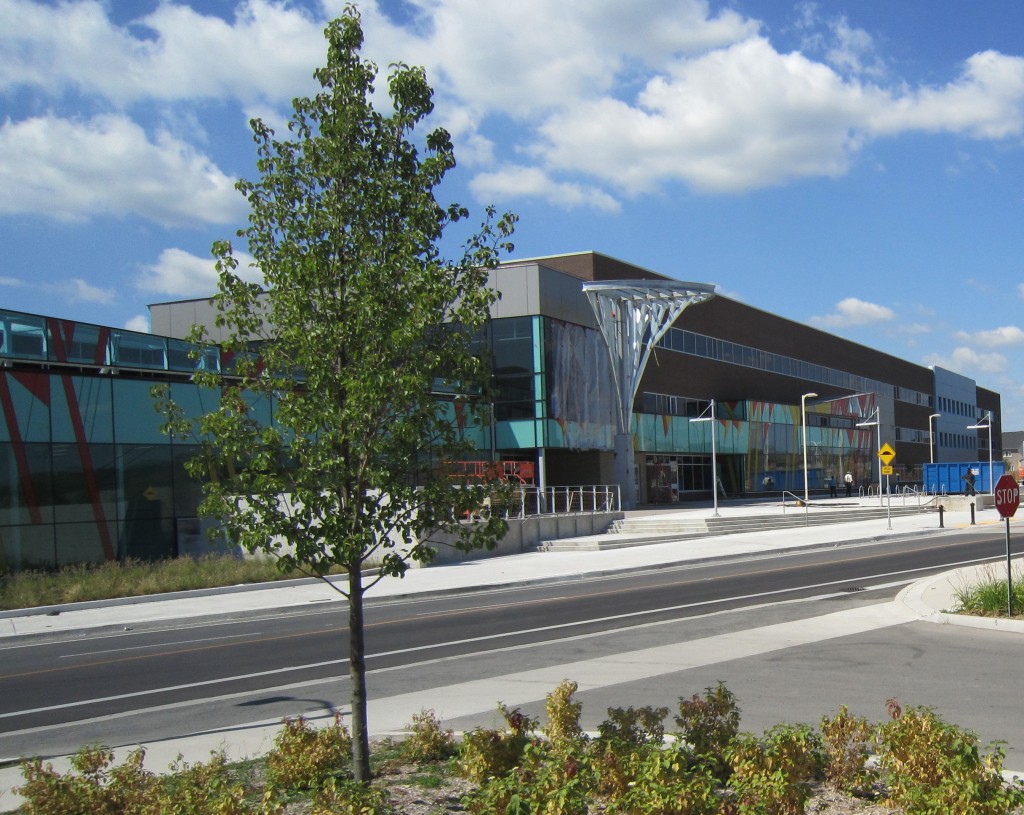 Was Hayden high school needed? Depends on what you wanted. The high school seats may not have been needed but the Board of Education, the Library and the city’s recreation department had skin in the game. The idea was to create a structure that would become a community centre and when that was decided upon – an excess of students seats got forgotten – the bureaucrats were building and if that meant the death of two high schools so be it. Where were the trustees at the time? Did they not see this coming and did they not ask questions? The point being for our business model, is that there is no apparent rationale, no business case, to build Hayden, as there was no shortage of supply of student places. There was already some identifiable surplus.
With such an excess supply identified, and projected to worsen, on the basis of this issue definition, what reason existed to build additional supply of students spaces at Hayden? In fact, we still don’t need Hayden on this basis.
If most people made this kind of business decision, they would be in deep doo-doo, and in deeper when there are serious consequences, which there are, but not for those who made the decisions.
This decision by the Board had no justifying business case in terms of student spaces, but created an excess which is now being used to justify closing schools to make up for their mistake.
Everyone knows this has just made things much worse and created a divisive mess for which no one is being held accountable.
Regarding the provision of student opportunities as a reason for the PAR, there was never any evidence provided to show that Hayden provided any opportunities that didn’t already exist. And there is still no evidence provided that closing other schools will provide any additional opportunities that also don’t already exist.
In fact, closing schools will require that 500 to 600 additional students are provided, rather “necessitated”, the “opportunity” to ride the bus to school instead of walk, which most of the would be displaced do at present. Some opportunity this is.
Hopefully, you can see the thinness of putting the issue as just about excess student spaces. The Board itself created the excess. It didn’t exist before Hayden.
Why was Hayden built? Where’s the cost-benefit analysis of what has been created?
The only thing I have even remotely heard, is that the people in the north of Burlington, in Alton, were entitled to, or “needed” schools in their neighborhood.
Which begs the question, what about the rest of Burlington, now under the gun because of the Board building a Hayden not needed for student spaces.
And here is where the real issue mess lies, the part left out of your issue definition.
Because the students were transferred in ever greater numbers, even overflowing into portables, exceeding the Hayden built supply of places, from the existing schools, and then their feeders, thus creating the excess in those schools.
 It is the trustees that are accountable. But the trustees who made the decision to build the Hayden high school aren’t there anymore. Of the 11 in office now eight are serving their first term of office. Burlington’s ward 5 trustee Amy Collard is serving her second term – both by acclamation, Trustees Kelly Amos from Burlington and trustee Donna Danielli from Milton were on the board at the time the Hayden high school decision was made. So that’s where this logic of this issue definition takes us. Based on this definition, Hayden should not have been built. Is anyone going to be held accountable for this?
If Hayden neighborhood residents and parents and students “needed” their own school, whatever happened to the rest of us down here in the south? Do we not count in this?
This is the real mess that this issue definition is too thin to manage. It is much more than excess student places, which is a red herring.
What have parents, residents and students to say about their concerns and what they want?
A perusal of the Gazette archive will get at least some sense of what some people are saying and/or want. As I noted earlier, one key thing that is missing on the accessible website are enough years of the LTAPs and reports to go back to the time that Hayden SS in Alton was being rationalized and justified. I described this situation in detail above.
So if the Trustees know that set of facts, and others do as well, what do they think resident feelings and concerns are?
 Tom Muir is a resident of Aldershot who has been a persistent critic of decisions made by city council. He turns his attention to the current school board mess. He recently suggested to Burlington city council that “If you are so tired of and frustrated by, listening to the views of the people that elected you, then maybe you have been doing this job too long and should quit. Tom Muir is a resident of Aldershot who has been a persistent critic of decisions made by city council. He turns his attention to the current school board mess. He recently suggested to Burlington city council that “If you are so tired of and frustrated by, listening to the views of the people that elected you, then maybe you have been doing this job too long and should quit.
Muir explains that the PARC will only get what people send in, what they come up with from their own efforts, and what they ask/demand from the board. They have to decide what they want and go after it ruthlessly. They will have to fight with tooth and claw and take no prisoners.
Previous articles:
Part 1
Part 2
Part 3

 By Tom Muir By Tom Muir
January 18th, 2017
BURLINGTON, ON
Part 3 of a series:
Tom Muir, an Aldershot resident, has been an active participant in civic affairs or more than 25 years. He has been described as “acerbic”, a fair term for Tom.
He has outlined, in considerable length, a large part of why the parents at Central and Pearson high schools are in the mess they are in as a result of the recommendation to close their schools. In this article, one of a series Muir suggest what he feels are obvious solutions to the problem the Board of Education believes it has. There is a lot of material; it gets dense at times. Living in a democracy means you have to accept the responsibility of citizenship and stay informed.
The Board of Education advised its trustees that there were 1800 empty seats in Burlington’s seven high schools. The Director of Education, Stuart Miller, brought forward a number of recommendations. The trustees decided to create a Program Accommodation Review Committee (PARC). That committee will begin its meeting later this month.
 Director of Education Stuart Miller, on the right engaging a parent at Central high school. The PARC will review the data – there is tonnes of it, and send a recommendation to the Director of Education who will then make his recommendation to the trustees who will make a final decision as to whether or not any high schools should be closed. The schedule calls for this to be done by May of this year.
Other ideas are suggested by residents in the on-line conversations in the Gazette. There are other more inclusive lists of such ideas elsewhere. Surely, the Board staff and consultants, and education researchers, have a cornucopia of ideas that just need to be unleashed. As Rudyard Kipling said, “there are 99 and 9 ways to make tribal lays.”
This, I think, is a way to go to get to a plan fitting with the times, changing demographics and adaptability to such changes, fairness, and the patterns of the Growth Plan for Halton.
 A new community was created when Hwy 407 was built. The Alton Village underwent significant growth requiring public and high schools. Some are not sure the high school was such a good idea.. It is just not right that existing residents are required to give up their schools, in order to build new schools in areas where the high growth in population is being directed under the force of the provinces’ orders in the Growth Plan.
Why should this be a forced confiscation in service of the province’s growth orders? Why should we pay for another part of the growth with our schools?
As I said, things are being taken too far in this insensitive and unlimited logic of efficiency, narrowly defined, leading to fewer and fewer schools in existing neighborhoods.
Once these school sites are gone, they are gone – there are no other places to site new schools. What kind of municipal and community planning is that?
And for those seeming to be okay with the closure of two high schools, as inefficient, and needing to be eliminated, I have to ask if they have ever considered what might be the limits of their criterion or their logic?
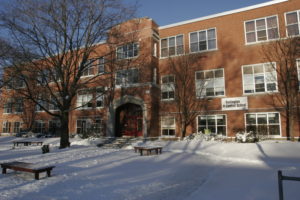 Burlington Central high school – the oldest in the city located in a neighborhood with intense loyalty to the place. There are some fourth generation students at the high school. Do they propose to applaud this process year after year until “most efficient” and “biggest” become synonymous with “only”?
Do these schools have any value not subsumed under the heading of “efficiency”? And who benefits by their closure?
Is “any” degree of “efficiency” worth any cost in our schools?
Can progressively closing more and more schools be treated with such regardlessness, by merely asserting a justification that leaves out all the cultural and community values that they embody?
The point being that there must be limits imposed to this process before our cultural institutions of education have been corrupted to calamity.
This process is leading to no good, and is rotten politics.
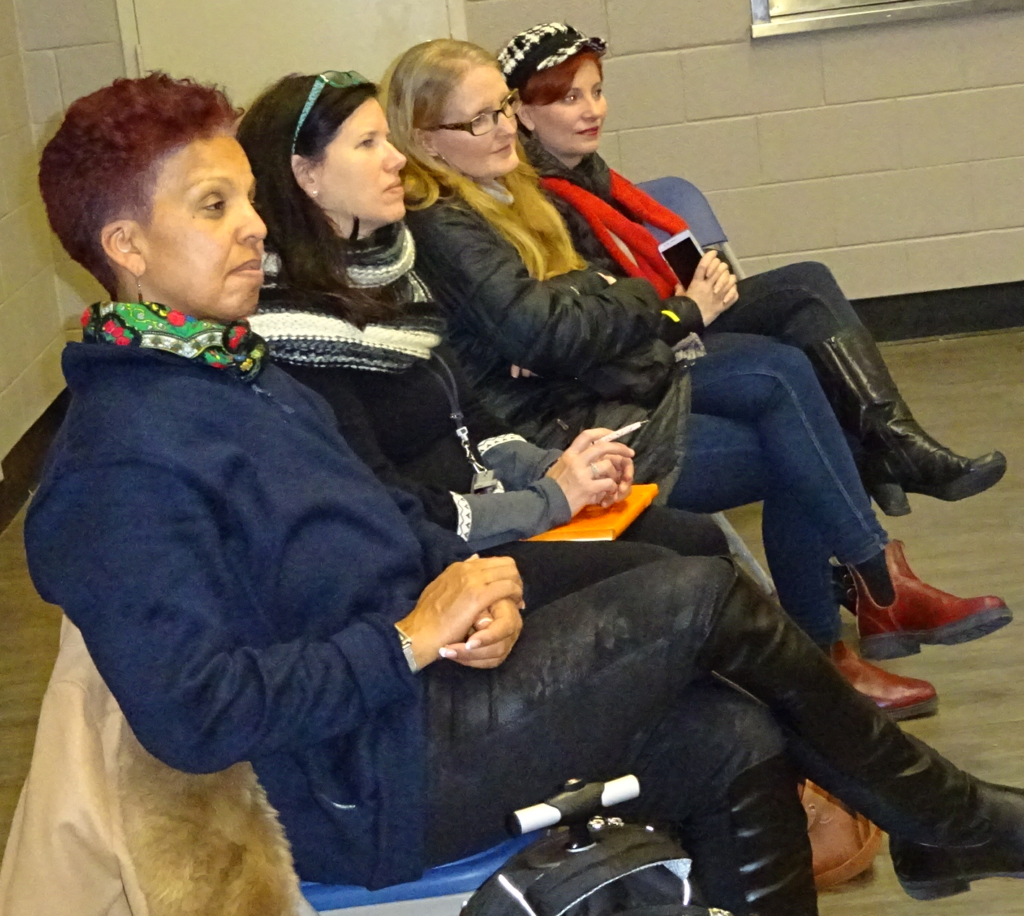 Halton District School Board trustees sit at the back of the room during a December public meeting. From the left: Papin, Reynolds, Ehl Harrinson and Grebenc. Some things the Trustees can do.
Hayden has 500 to 600 pupils too many in the LTAP forecast. The Board moved 600 to 900 from the area of concern, such as Pearson, Nelson, Bateman, and Robinson. You can see this in the capacity utilization rates in the Board reports and reproduced in the Gazette.
They can simply move some number like the 600 back, as they have the power to do that, just like before, when they moved them out. We need to know what the numbers by school were that were moved to Hayden.
They can even shuffle students from Hayden around the Board SRA 100, which is also in the plan but only at a low scale. Shifting students and programs around all of Burlington, including SRA 100, can be considered.
 Secondary Review Area where all the high school are concentrated. Closing portables and using the bricks and mortar OTG capacity for students fits into using excess spaces, and is something that parents and students have expressed the desire to see. It will certainly be better for students.
Closing the 2 schools mentioned is reported to mean almost 600 more students from them need to be bused, increasing the number from 1000 to 1600.
So no closures, and moving students from Hayden back to the other schools – some of which is in the Option 19 for French Immersion at least – is a perfectly logical thing to do.
It will also save significant busing dollars (not specified in the reports I saw), that won’t need to be added to the already $15 million transportation bill of the Board as a whole, and will avoid big disruptions to students lives.
At least one or two SRA 100 schools are close enough that busing of students is not needed.
Again, shuffling the excess around, and changing the catchments accordingly are all possible and will facilitate the adjustments.
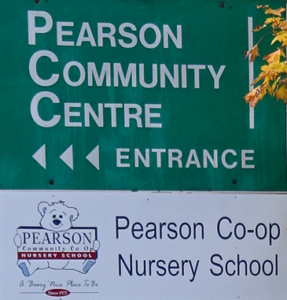 The Lester B. Pearson high school was “purpose built” with an extra gymnasium and a Day Care Centre. The Halton Board has many programs scattered around, and these can be expanded perhaps by shifting some to schools with surplus space.
The Community Partnerships and Hubs outreach, partly funded and touted by the Province on their website as involving schools, can be tapped to expand uses of space.
The existing daycare at Pearson is exactly what the province mentions as one of the possibilities. What happens to that with a closure of Pearson and Central?
Where are these options in the plan? These things are obvious solutions.
I’m confident that the PARC members also have a great number of ideas, and they are much more intimate with the schools and what they want than I am.
 Tom Muir; an acerbic community advocate. Tom Muir is a resident of Aldershot who has been a persistent critic of decisions made by city council. He turns his attention to the current school board mess. He recently suggested to Burlington city council that “If you are so tired of and frustrated by, listening to the views of the people that elected you, then maybe you have been doing this job too long and should quit.
Muir explains that the PARC will only get what people send in, what they come up with from their own efforts, and what they ask/demand from the board. They have to decide what they want and go after it ruthlessly. They will have to fight with tooth and claw and take no prisoners.
Previous articles in this series:
Part 1
Part 2

 By Pepper Parr By Pepper Parr
July 15th, 2015
BURLINGTON, ON
There were two meetings – both took place at the same time, in the same room.
Many people were not fully aware of the meeting that mattered to Mike Wallace.
The scheduled meeting was the Burlington provincial Progressive Conservative Annual General Meeting at which a new board was installed. The other meeting, taking place at the same time was former Member of Parliament Mike Wallace creating the campaign team he will need in 2018.
Wallace is going to take a shot at getting the job as Mayor of Burlington.
Here is the time line he is working within.
The next provincial election is “scheduled” for June of 2018.
The next municipal election will take place in October of 2018.
At the Burlington Provincial Progressive Conservative riding association Saturday forenoon the new board was put in place.
 Nominee Jane McKenna at the Progressive Conservative AGM last Saturday? And it was announced that Mike Wallace as going to run Jane McKenna’s election campaign whenever the provincial election is called.
The municipal election date is cast in stone – the provincial election can take place whenever Kathleen Wynne decides to call it. The Burlington provincial Progressive Conservatives believe they are ready.
They appear to have the money in the bank and they now have a Board and an Executive that will do what Wallace needs them to do.
McKenna’s chances of getting returned to Queen’s Park are slim unless the Premier really screws up – and that may well happen.
For Mike it doesn’t matter all that much. He will put together a campaign team and do the best he can with what he has. Running Jane McKenna against Liberal Eleanor McMahon is an uphill battle – too early to attempt to call that one – except for the fact that McMahon is the much better campaigner. She has a genuine touch for people that McKenna is never going to be able to match.
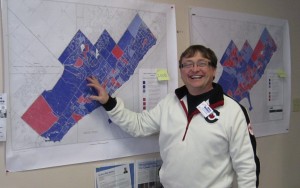 Can former MP Mike Wallace keep all those Tory blue votes when he runs for the office of Mayor in 2018? That too doesn’t matter – Wallace will do the best he can with what he has. He will put together a superb team; there are some very accomplished Tory political operatives in Burlington and the party still believes that the heart of this city is still conservative. I think Karina Gould has proven that may no longer be the case
This city has more than enough in the way of Tory party faithful who will heed the call and turn out and pull in the vote.
 The night of the last federal election, which Mike Wallace lost to Karina Gould. Mayor Goldring went to the Wallace campaign offices first and then went to the Gould campaign offices later to congratulate the winner. Did Goldring misread the tea leaves? What Mike Wallace gets out of this is a well-oiled campaign machine that he will use to propel him into city hall where he will get to wear the chain of office.
Wallace served as a city Councillor for a number of years and was the Member of Parliament for Burlington until Gould defeated him.
The race for Mayor of Burlington in 2018 looks like it will be between Rick Goldring, Mike Wallace and Marianne Meed Ward.
Wallace will eat into the Goldring voters – the Meed Ward voters will remain firm.

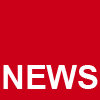 By Staff By Staff
January 15th, 2017
BURLINGTON, ON
Sometime Monday forenoon Jim Young will take to the podium at city hall and brief members of Council on the 28 page document he prepared on what the Senior’s Advisory Council would like to see done with transit.
Jim Young has been advocating for better transit for some time. He came close to getting a change during the budget debates in 2016 when he wanted the city to make transit free for seniors on Monday’s.
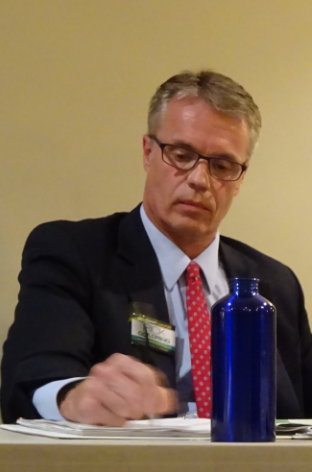 Mayor Rick Goldring voted for the transit pilot program in the 2016 budget. 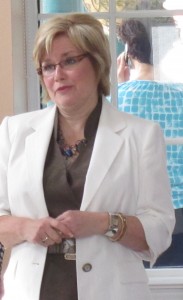 Ward 6 Councillor Blair Lancaster voted for the pilot transit program in the 2016 budget 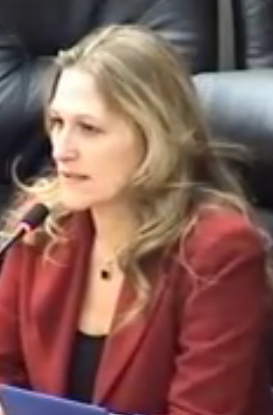 Ward 2 Councillor Marianne Meed Ward voted for the transit pilot program during the 2016 budget. The Mayor, Councillor Meed Ward and Councillor Lancaster voted for what was to be a pilot program. The Director of Transit at the time wasn’t for the idea. He has since left the city.
Councillor Craven is reported to have told an Aldershot resident that he liked the program – but he did not vote for it – that may have been because almost anything Councillor Meed Ward puts forward, Craven opposes. He didn’t speak at any length on the matter during the debate.
Councillor Paul Sharman voted no – he wanted more data. Councillor Sharman always wants more data before he makes a decision – there does come a point when a decision has to be made based on experience and wisdom. There was the sense that the asking for additional data was punting the ball off the field.
Councillor John Taylor voted no – saw free transit as social welfare which most people didn’t need. Councillor Taylor couldn’t help but see free transit as some form of social welfare; his mind is still stuck in that old style thinking.
 Councillor Taylor saw free transit as part of the social welfare system – a Regional responsibility. One wonders why Taylor does not label the $225,000 that is forgone in terms of parking fees for the free parking members of staff get every year. With that kind of money the city could make the transit service free to everyone.
Councillor Dennison voted against the proposal.
Young personifies persistence and so he will be at it again on Monday asking council to put more money into transit.
The paper he has presented was adopted by the Burlington Seniors’ Advisory Committee: November 14, 2016.
The chances that every member of council will actually read all 28 pages is slim.
Here is a short summary of what Jim Young wants your city council to do to improve transit.
Improving Transit for Seniors Improves Transit for All
Improved Frequency and Reliability of Transit Service
Synchronize Smaller Community Buses to Larger Bus Hub to Hub Routes
Routing community bus services through satellite Seniors Centres
Restoring Service Stops in Major Malls
A Return to 70/30 Division of Transit/Roads Gasoline Tax Funding
Filling the City’s Buses During Off-Peak Hours
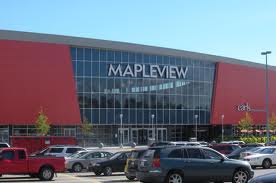 At busy holiday shopping periods buses get trapped in Maple View Mall – killing schedules. The Major Objectives of the BSAC Paper are:
To improve service and increase ridership of Burlington Transit.
To get more people out of cars and on to transit.
To move the city towards achievement of its 25 year Strategic Plan.
Contribute to growth in our city.
Reduce traffic congestion and improve road safety in Burlington.
Reduce CO2 emissions and help limit global warming.
Provide a safe, dignified means of transport for many who suffer restricted mobility.
Address the paradox that those most in need of public transit are those least able to afford it.
“Public transit is one of the most complex issues facing cities and indeed nations today. It poses a series of problems that are complicated and difficult to solve. Every city, every politician wants successful transit systems.
They move people, contribute to growth, reduce congestion, improve road safety, reduce CO2 emissions, help limit global warming, provide a safe means of transport for many who would otherwise suffer restricted employment and social mobility.
The paradox is that those most in need of public transit are those least able to afford it. The elderly, the young, the working poor, students, single parents, physically and intellectually challenged citizens and, returning to the elderly, those who have had driver’s licenses rescinded due to age related health issues.
Putting aside any notion of “seniors entitlement”, Burlington Senior Advisory Committee (BSAC) wants to add the voice of seniors’ experience, knowledge and love of our city to the transit debate. Of course we recommend improvements in transit that benefit seniors, but we do so very firmly from the perspective that: “Whatever Improves Transit for Senior’s, Improves Transit for Everybody”. This philosophical principle improves transit for our children and grandchildren, improves transit for Burlington and improves Burlington as: A City that Grows, A City that Moves, A Healthy and Greener City, An Engaging City, achieving all of the elements of our city’s 25 year strategic plan.
 Burlington Transit getting new buses – to deliver less service. Among politicians there is an almost universal love affair with the benefits of public transit. This is logically offset by concerns about how cities will finance the level of public transit required to achieve all of our lofty goals. The dichotomy has always been whether to wait for increased ridership to justify the cost of improving transit or, to invest in improved transit and trust that the ridership will follow.
This BSAC position paper hopes to point a way that allows Burlington to take some simple, relatively inexpensive actions that will increase ridership, contribute towards some of the social and environmental issues facing every city, and offer medium and longer term improvements that might make Burlington Transit a model for other medium sized city transit systems which becomes a showcase for the city worldwide.
A number of weeks ago Young upbraided city council for forgetting just why they were eleted. At that time he said:
When you deny constituents the reasonable opportunity to advise you during council term at meetings such as this, you leave them no other option but to voice their frustrations through the ballot box at election time.
Look at recent election results, where voters vented their frustration at the perception that politicians are not listening, do not provide the opportunity for citizens to be heard, a perception that has given voice to the Fords, the Trumps and the Brexiteers who, bereft of policy or vision or even civil discourse, at least pretend to listen, pretend they will be the voice of the people.
Then proceed to undo all the good that has been done, the community that has been built by that slow and frustrating democratic process.
I will finish by challenging each of you who wish to limit the participation of citizens in the affairs of our city:
Will you please explain to this gathering tonight how limiting delegations to 5 minutes is good for our democracy, good for our city?
Will you then publish that explanation in your Newsletter for all your constituents to see and to judge for themselves?
Will you stand at your regular town hall gatherings and tell the people of your wards why you want to silence their voice?
Because you will stand before them in 2018 and they will demand to know.
The motion to reduce delegation time at Standing Committee from ten minutes to five was defeated – in some measure due to the comments Young made.
Will he manage to convince council to re-think the way they fund transit?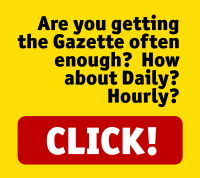

 By Ray Rivers By Ray Rivers
January 12, 2017
BURLINGTON, ON
He should be remembered in history as one Canada’s Fathers of Confederation. But those in that part of the country we call English-speaking will only recall how, as Liberal leader, Stephane Dion mangled his presentation on why the three opposition parties had agreed to form a coalition to claim the minority 2008 government back from Stephen Harper.
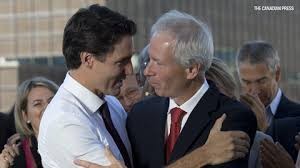 Buddies forever? Prime Minister knew he had to remove Stephane Dion from Cabinet. Feelings are badly damaged. An un-cooperative TV network, a personal panic attack and poor English all contributed to his misadventure. That incident plus Harper’s secret meeting with the governor-general allowed the Tories to stay in power, and the landmark agreement for the thee left-wing parties to unite became history.
Among Quebec separatists, Dion is hated for introducing the Clarity Act, which has driven enthusiasm for Quebec independence to record low levels, Following the second Quebec referendum, Jean Chretien needed an intellectual to deal with the sovereignty problem. He became so enamoured with Dion that he appointed him as Minister of Intergovernmental Affairs before he even had a seat in the House.
 A minister with a strong academic streak that served the country well. Dion’s Clarity Act keeps the country together. Then, based on advice Dion had sought from the Supreme Court, his Clarity Act ensured that Ottawa would need to approve all future referendum questions. In addition, a strong majority of voters would be required (greater than 50%) in order for the results to be deemed conclusive. And finally, any movement to sovereignty would have to be through negotiation rather than a declaration of independence, as the separatists had planned to do following the 1995 referendum.
Dion had been an academic before he became a politician, a man of principle who once campaigned for the separatists before realizing he truly believed in federalism. But the times have now changed and so must the make-up of the guard. So Justin Trudeau has offered him a diplomatic posting and given the job of Minister of Global Affairs to someone else. Sure Dion had not performed well on that armoured car deal with Saudi Arabia, but it’s the need to confront the changes in Washington which has convinced the PM that he needs a different kind of foreign minister.
 Chrystia Freeland in the House of Common during Question Period. So Chrystia Freeland, an Albertan of Ukrainian decent, has been named the new minister to help guide Canada internationally as we enter the era of Donald Trump. Trump, the business man, is expected to treat international issues largely from a transactional rather than principled perspective. It will be about the deal and everything and anything is up for grabs, a policy view shared by his friend Vladimir Putin, whom US security services are now convinced hacked political websites to help Trump win the last election.
 Minister of Global Affairs Freeland will set policy and create a different Liberal party. Freeland, a former student and author of Russian and slavic history is well positioned for her new role as Canada’s chief diplomat. That presumes that Putin lifts the sanctions he imposed on her in retaliation for the ones Canada placed on Russia following the seizure of Crimea. And beyond Europe, Freeland has spent considerable time in the US as a business journalist and panelist on talk shows. She is well positioned to engage with Trump and his Secretary of State whatever their philosophical differences. She once demonstrated her skills by walking out on free trade negotiations with the EU, a tactic which brought the deal home for Canada.
Prime Minister Trudeau has also made a couple of other changes to his Cabinet to coincide with the changing of the guard south of the border. Long-timer John McCallum is leaving the immigration post, which he served so well during the Syrian refugee crisis. He is being given a diplomatic posting as ambassador to China, a nation which has become a priority for Canada in regards to trade policy. There are also potential security issues at stake as tension continues to rise over China’s aggressive territorial claims, and the US response. This is particularly an issue since president-elect Trump has been baiting the Chinese, first on trade and more recently on relations with Taiwan.
And Burlington has made the big time with newly minted MP Karina Gould becoming the Minister of Democratic Institutions. It is a troubled file, formerly overseen by MP Maryam Monsef, who is being moved to the Status of Women. In the latter days of the 2015 election campaign, many Green and NDP-inclined voters switched their loyalty to the Liberals on the promise made by Justin Trudeau that 2015 would be the last federal election under first-past-the-post (FPP) rules. Those votes contributed to his majority victory and the PM will have to deliver on that promise.
 Karina Gould accepting congratulations from former Burlington MP Mike Wallace. Monsef who had created a parliamentary committee to develop options to (FPP) was finessed by her own committee. They not only recommended implementation of a complicated mixed-member proportional system but also that the government hold a national referendum before making changes. Since this could not practically be completed prior to the next vote in 2019, the PM would have failed to deliver his promise. Gould has her work cut out to pull off a miracle such that the party retains its credibility.
It is a pretty normal routine to periodically shake up a Cabinet, bring in new blood and reward those who have performed well, as is the case for Freeland. That the shuffle wasn’t even greater must mean that the PM is relatively content with how the rest of his ministers are carrying out their responsibilities. And of course, with two vacancies, there will soon be new by-elections to test whether the public agrees with the PM.
 Ray Rivers writes weekly on both federal and provincial politics, applying his more than 25 years as a federal bureaucrat to his thinking. Rivers was a candidate for provincial office in Burlington in 1995. He was the founder of the Burlington citizen committee on sustainability at a time when climate warming was a hotly debated subject. Tweet @rayzrivers Ray Rivers writes weekly on both federal and provincial politics, applying his more than 25 years as a federal bureaucrat to his thinking. Rivers was a candidate for provincial office in Burlington in 1995. He was the founder of the Burlington citizen committee on sustainability at a time when climate warming was a hotly debated subject. Tweet @rayzrivers
Background links:
Cabinet Shuffle – Chrystia Freeland – More Freeland –
Freeland Sanctions –
John McCallum –
Stephane Dion – More Dion –
First Past Post –
Dion a Hero –

 By James Burchill By James Burchill
January 12th, 2017
BURLINGTON, ON
Oh come on! FREE is free. Zero, zip, nada, zilch. What on earth could be better than FREE?
I recently mentioned online that FREE was the most powerful word in advertising. Nothing has changed, it still is.
So what is with the headline of this article? What is better than FREE?
Well before I explain, let’s recap a little first. FREE is the most powerful word in marketing and advertising world because at its very heart lies the secret of ‘risk reversal’. If you make your offer as close to risk-free as possible you will be ahead of most of your competition.
Beyond Risk Reversal
Getting over the risk associated with making the wrong choice, or making the choice and then having the product under deliver or simply not work, is a problem that every buyer struggles with. And for what it’s worth, most people are more afraid of making the wrong choice and looking foolish, than they are of just making the wrong choice.
So if you can negate this fear, if you stack the deck in your favour. If you can get the buyer over that hurdle, they will be one step closer to saying “yes”.
Let’s Dance
In any business transaction there is a silent dance that plays out every time someone offers something for sale, and someone considers buying it. Each party silently tries to maneuver themselves into a position where their risk is limited. As the seller, you can help the buyer get to that place if you assume all or more of the risk, then you will have less trouble selling your product or service. It’s that simple.
“But James, nothing in life is really free.”
Well, that is true to some extent. Even if I gave you something free, what it really means is that you did not have to part with any money. You paid no cash. You may still have spent time and energy on the sales process; you may have invested yourself emotionally in the prospect of owning that flashy newfangled widget.
Therefore, in reality, you have ‘spent’ something – you spent time. And time unlike money is non-refundable. Time is finite and as the old saying goes… “Time waits for no man.”
So if your prospect has accepted your request to explore the possibility of buying something from you, and has even gone so far as to consider making a deal with you, what can you do to clinch it? Well you can let them know you value their time. You can show them you respect them for taking the time to meet with you. You can show them that you appreciated their consideration of your product or service.
And The Answer Is…
And so the answer to your question ‘what is better than free?’ is ‘Better Than Risk Free’ or ‘BTRF’ for short.
Simply put, a BTRF offer rewards your customer for favouring you with their buying decision. In addition, if it does not work out – you compensate them for their efforts. Here is a concrete example:
 Whether you sell products or services, give the client something extra as part of the main deal. If the extra premium is free, then so much the better. To make the deal even stronger, make it known that the whole deal is 100% guaranteed and you’ll refund their money if required (or whatever makes sense) and also let them know that regardless of the deals outcome, (and this is the BTRF part) they get to keep the premium item you gave them as your way of saying thank you. Whether you sell products or services, give the client something extra as part of the main deal. If the extra premium is free, then so much the better. To make the deal even stronger, make it known that the whole deal is 100% guaranteed and you’ll refund their money if required (or whatever makes sense) and also let them know that regardless of the deals outcome, (and this is the BTRF part) they get to keep the premium item you gave them as your way of saying thank you.
‘Better Than Risk Free’ is better than free.
 James Burchill is the founder of Social Fusion Network – an organization that helps local business connect and network. He also writes about digital marketing, entrepreneurship and technology and when he’s not consulting, he teaches people to start their own ‘side hustle.’ James Burchill is the founder of Social Fusion Network – an organization that helps local business connect and network. He also writes about digital marketing, entrepreneurship and technology and when he’s not consulting, he teaches people to start their own ‘side hustle.’

 By Staff By Staff
January 10th, 2017
BURLINGTON, ON
While we appear to rank as the #1 mid-sized city in Canada as one of the best places to live – we rank just 5th as the city that most values monogamy which is defined as being faithful to your husband/wife and not flirting with people of the opposite sex.
This conclusion came out of the latest large-scale Canadian study that analyzed anonymous user data from 20,000 EliteSingles members to discover the cities in Canada where people most value monogamy Burlington took the #5 spot!
 The top 10 cities where you can find monogamous people, as well as the top 10 cities where you can find monogamous men and monogamous women (and Burlington features on all three lists, coming 5th overall, 7th on the men’s list, and 8th on the women’s). The top 10 cities where you can find monogamous people, as well as the top 10 cities where you can find monogamous men and monogamous women (and Burlington features on all three lists, coming 5th overall, 7th on the men’s list, and 8th on the women’s).
• Overall, the Canadians most enthusiastic about monogamy are from Aurora, ON
• Whitehorse, YT and Port Moody, BC take second and third place
• Canada’s most monogamous men are from Port Moody, BC
• The nation’s most monogamous women can be found in Stratford, ON
The study, which was conducted by premium dating site EliteSingles, used anonymous user data from 20,000 registered members to determine just how much Canadians prioritize monogamy.
The study looked at the extent to which the randomly selected participants agreed with the statement ‘I believe that monogamy is essential in a relationship.’ These scores were then averaged out by area, revealing the Canadian cities where people are the most likely to be mad for monogamy:
The top 10 cities in which to find Canada’s most monogamous people:
1. Aurora, ON
2. Whitehorse, YT
3. Port Moody, BC
4. Spruce Grove, AB
5. Burlington, ON
6. Airdrie, AB
7. Langley, BC
8. Okotoks, AB
9. Maple Ridge, BC
10. Kelowna, BC
 Participants in the study were asked to rank the extent to which they agreed with the sentiment ‘I believe that monogamy is essential in a relationship’; placing themselves on a scale of 1 (do not agree at all) to 7 (agree completely). As it turns out, Canadians are strongly in favour of monogamy: the average result for women was 6.3, while men average 5.7. Participants in the study were asked to rank the extent to which they agreed with the sentiment ‘I believe that monogamy is essential in a relationship’; placing themselves on a scale of 1 (do not agree at all) to 7 (agree completely). As it turns out, Canadians are strongly in favour of monogamy: the average result for women was 6.3, while men average 5.7.
As well as determining the averages overall, the study looked at answers geographically, determining an average result for each location and thus revealing the ten cities in Canada that are home to the most monogamous people overall, as well as the cities that are home to Canada’s most monogamous men and most monogamous women.
The organization that did the survey is a dating site that manually confirms the existence of every client.

|
|
 And the Muslim ban. This was as poorly considered as so many of his other actions since becoming president. None of the people living in those seven banned countries are known to have committed acts of terror in America over the last quarter century. And yet almost three thousand Americans have been killed by citizens from Saudi Arabia, the UAE, Egypt and Lebanon – Muslim countries where Trump has business interests and which are therefore exempt form his ban.
And the Muslim ban. This was as poorly considered as so many of his other actions since becoming president. None of the people living in those seven banned countries are known to have committed acts of terror in America over the last quarter century. And yet almost three thousand Americans have been killed by citizens from Saudi Arabia, the UAE, Egypt and Lebanon – Muslim countries where Trump has business interests and which are therefore exempt form his ban.


























































































 Ray Rivers writes weekly on both federal and provincial politics, applying his more than 25 years as a federal bureaucrat to his thinking. Rivers was a candidate for provincial office in Burlington in 1995. He was the founder of the Burlington citizen committee on sustainability at a time when climate warming was a hotly debated subject. Tweet @rayzrivers
Ray Rivers writes weekly on both federal and provincial politics, applying his more than 25 years as a federal bureaucrat to his thinking. Rivers was a candidate for provincial office in Burlington in 1995. He was the founder of the Burlington citizen committee on sustainability at a time when climate warming was a hotly debated subject. Tweet @rayzrivers Whether you sell products or services, give the client something extra as part of the main deal. If the extra premium is free, then so much the better. To make the deal even stronger, make it known that the whole deal is 100% guaranteed and you’ll refund their money if required (or whatever makes sense) and also let them know that regardless of the deals outcome, (and this is the BTRF part) they get to keep the premium item you gave them as your way of saying thank you.
Whether you sell products or services, give the client something extra as part of the main deal. If the extra premium is free, then so much the better. To make the deal even stronger, make it known that the whole deal is 100% guaranteed and you’ll refund their money if required (or whatever makes sense) and also let them know that regardless of the deals outcome, (and this is the BTRF part) they get to keep the premium item you gave them as your way of saying thank you. The top 10 cities where you can find monogamous people, as well as the top 10 cities where you can find monogamous men and monogamous women (and Burlington features on all three lists, coming 5th overall, 7th on the men’s list, and 8th on the women’s).
The top 10 cities where you can find monogamous people, as well as the top 10 cities where you can find monogamous men and monogamous women (and Burlington features on all three lists, coming 5th overall, 7th on the men’s list, and 8th on the women’s). Participants in the study were asked to rank the extent to which they agreed with the sentiment ‘I believe that monogamy is essential in a relationship’; placing themselves on a scale of 1 (do not agree at all) to 7 (agree completely). As it turns out, Canadians are strongly in favour of monogamy: the average result for women was 6.3, while men average 5.7.
Participants in the study were asked to rank the extent to which they agreed with the sentiment ‘I believe that monogamy is essential in a relationship’; placing themselves on a scale of 1 (do not agree at all) to 7 (agree completely). As it turns out, Canadians are strongly in favour of monogamy: the average result for women was 6.3, while men average 5.7.